#sharing such people would be a fun inspiring insight into the history
Explore tagged Tumblr posts
Text
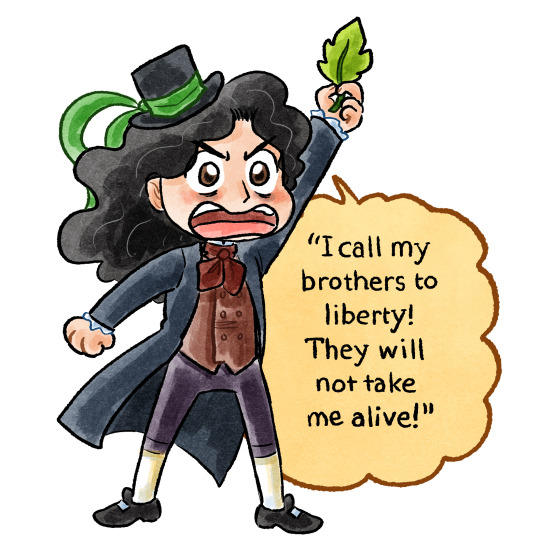
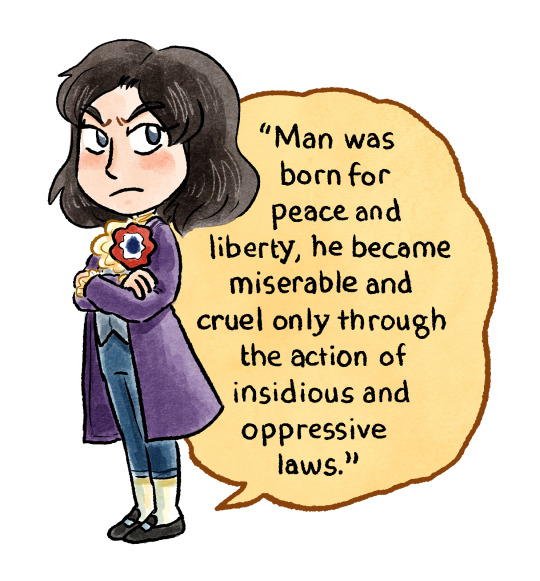

Some little doodles and inspirational quotes from Camille Desmoulins, Louis Antoine Saint-Just, and Maximilien Robespierre 💖
I've made these 3 cos I'm making some stickers for a comic convention thats very soon, and did the most 'famous' people for starters/who ppl following me might know from my comic :3
But when I have free time I'm definately gonna make some of lesser discussed but equally inspiring revolutionaries~
#It would be awesome to make some of the women and black ppl involved in Frev#I think for ppl not into Frev who are attending cons#sharing such people would be a fun inspiring insight into the history#but I want to do my research first on such people before I make stickers of them#to get their personalities right and find cool quotes~#frev#french revolution#frev art#camille desmoulins#louis antoine saint just#maximilien robespierre#saint just#robespierre
278 notes
·
View notes
Note
Hi Mark,
My name is Isaac Holguin. I sent a detailed email regarding your work on the color pie over the years to [email protected]. I hope that is the correct avenue to reach out to you. I had the pleasure of being answered on this blog as well, so I thought I'd double check by contacting you here. In case the email listed isn't in service anymore, I've copied my message below. I hope this reaches you and that you're doing well. If you're able, I'd love to hear back at [email protected]. Thanks for all you do!
----------
Hello Mr. Rosewater,
My name is Isaac Holguin and I'm a nurse studying leadership and education in Tucson, Arizona. Before I get into the topic of my email, I'd just like to say thank you for being a spokesperson for Magic the Gathering all these years! I've played the game since I was thirteen years old, all through college, and well into my career. Magic the Gathering has helped me make new friends and deepen bonds with people I already had in my life. Though I've stopped participating in recent years, the game will always hold a special place in my heart and I've still got an Alpha Serra Angel that is as old as I am!
One of the best memories I have from my time with Magic was diving into the color wheel breakdown series from your "Drive to Work" podcast. During my pursuit of a Bachelors in Nursing Science, I often cited the color wheel as a tool to determine personality traits and compared it to other topics in my studies. Now that I'm pursuing my Master's degree in Nursing Education, I'm interested to see if there were any references or inspirations for the development of the color pie. With the recent popularity of the Myers-Briggs assessment (16 Personalities), Ten Faces of Innovation, and other similar tools I'd like to try and adapt the color pie as a leadership/personality assessment. I understand there will be multiple steps involved to publish such a study with respect to Hasbro and Magic the Gathering as a company, but I would like to attempt to lay the foundation of this project during my studies.
The goal of this project would be to introduce an existing, incredible, fun, and easy to use tool to a vast new audience. Helping others acknowledge that all aspects of the personalities presented exist within them to some degree and can evolve over time has become a core belief for me both personally and professionally. Examples of "your greatest weakness is your greatest strength pushed too far" and the idea that the capacity for good and evil exists in any aspect of a personality are incredible insights that I haven't seen cited enough throughout my studies. My wildest hope is that this tool would be utilized in coursework for multiple professions, similar to the curriculum I'm studying now, to help future leaders reflect on their strengths and develop effective leadership styles.
In short, I hope that you're doing well and would love to hear your insights, recommendations, and references for the work you've so passionately brought to thousands of others of the years. Even if you're unable to share certain aspects of your work, I'd like you to know that your endeavors have not only brought relief and happiness to healthcare workers like me, but that you've inspired so many others to apply the lessons of fictional works to improve our reality. The lessons gained from my long history with this franchise have helped me connect to others in their most vulnerable moments, and improve their quality of life. Thank you for all that you've done, and I wish you continued success in a field you've already become an exemplary expert in.
Sincerely,
Isaac Holguin
BSN, RN
I’m always excited to hear about ways people can use the color pie outside the context of the game. I’m not sure what I can do to help you.
51 notes
·
View notes
Text
My Ideal Role as an Environmental Interpreter
My ideal role as an environmental interpreter would most likely be at a national park surrounded by greenery and a calming body of water, like Pinery Park. I imagine I would lead nature walks and hikes through the forest, sharing the story of our environment and its importance in ways that inspire and educate. My focus would be to help visitors understand that protecting and maintaining our environment is both a vital responsibility and a unique opportunity to connect with nature.

The boardwalk leading to the beach at Pinery Park, taken a couple years back from a family camping trip.
To ensure the audience gets the most out of the experience, I would incorporate engaging activities and exhibits that connect them to their surroundings. Whether it’s a competitive approach where they are required to complete a nature bingo card to spot native plants and animals, or a passive where I allow them to touch certain plants or animals. My goal will be to show how we all play a role in conservation, whilst trying to leave visitors in awe of the beauty and complexity of nature. Truth is we often fail to stop and appreciate the simple, everyday wonders around us. Through my work, I’d strive to change that, to encourage people to notice, value, and respect the world they live in.
As an environmental interpreter, I’d hope to inspire people to take action. By invoking a deeper love for nature, I want visitors to take away more than just a fun experience. I want them to feel motivated to make small and meaningful changes. Whether it’s reducing pollution, conserving resources, or simply being mindful of the impact we have on the planet. This is important because the health of the environment isn’t just crucial for us as humans, it’s essential for the plants, animals, and other organisms that share this world with us.

A picture taken we headed to the beach for a swim!
This role would demand a range of skills. Knowledge of environmental science, ecology, and cultural history would be essential to provide meaningful, accurate insights. Storytelling, however, would be just as important. Being capable of sharing information in a way that can captivate and engage a diverse audience is a skill that can make even the most ordinary facts into something unforgettable. Creativity would also play a major role, through designing unique activities and exhibits that will leave a lasting impression. People are most drawn to experiences they’ve never had before, and as an interpreter, it would be my job to craft moments that spark this curiosity and joy, creating a core memory.
This would align perfectly with my future goals of pursuing a career in nature to contribute to healing the environment. Linked with my love for the outdoors a the desire to make a change and difference, the role of an environmental interpreter would fit pretty well. I’ll share my appreciation for the natural world, and aim to inspire others to see its beauty and importance, just as I do.
Ultimately, this work would have a larger goal: to create a ripple effect of awareness and care. Through education, storytelling, and connection, I would strive to encourage others to respect not just nature but the entire world we live in, essentially pushing for a version of “world peace” that includes every living being, from the smallest plant to the largest animal.

A sunrise picture taken from the beach.
0 notes
Text
MDA20009 Digital Communities Fifth Blog post week 9
Topic:
Finding My Place in a Fandom: A Journey of my Community and Connection
Hey everyone! Super excited to share my story with you all again! So, today’s topic is all about fandoms. Honestly, I used to be the type of person who wasn’t into any of that—no fan groups, no following fan pages, none of it. But, as they say, time changes people, and here I am now, fully embracing the fandom life!

Discovering the Fandom Community
So It started with a single interest, a piano piece compose by Chopin that caught my attention and slowly grew into it more the I aspect. Suddenly, I was part of something bigger, an online community is a Instagram page of people who shared my fascination, my theories, and sometimes even my strange sense of humour, my behaviour captures the essence of fandom: a community driven by intense enthusiasm that interacts with society, shaping new cultural meanings and values through shared social experiences (Fuschillo, 2018). Now I realise that Fandoms have this unique way of turning all people who have same interest into friends, and for many of us, they become spaces that offer acceptance, understanding, and an endless source of connection.
Why I Feels Like Home in the fandom communities

My Fandoms communities often feel like a home away from home. They’re places where you can express excitement without judgment I mean sometimes, We share our quirky, unpopular opinions and crack up over inside jokes that only fellow fans would get. For instance, we speculate: if Chopin, the legendary piano composer, had lived longer or if Poland hadn’t been invasion by imperial Russia, would his musical style have evolved differently? Would some of his iconic pieces even exist if history had taken a different turn? It’s all part of the fun! I found myself surrounded by people who saw the little details and appreciated them as much as I did. Being in a fandom meant finding a group of people who not only enjoyed the same things I did but understood why I cared so deeply about certain things.
This sense of connection goes beyond just shared interests. Fandoms can offer a unique type of support. If I posted a question, I’d get responses from fans who wanted to help, offer insight, or just share in my curiosity. In those moments of excitement, when someone shares a piece they’ve just discovered, I feel thrilled to explore something new along with them. And whenever someone learns a new piece and posts it on the page, I share in their happiness because I know firsthand the effort and dedication it takes to practice and improve.
Finding My Voice ( My Species )
One of the best parts about joining a fandom has been discovering ways to contribute. Watching others create fan art, write fanfiction, or discuss music theories really sparked my own creativity. Whether it was doodling, writing, or making memes, I felt inspired to join in on this collaborative, creative space. Even though I don’t often post my own content, I find myself quietly enjoying and appreciating everyone else’s work. It’s funny, but despite not engaging much, just liking and sharing posts makes me feel connected and part of the fandom community in a meaningful way.

A World Without Borders
Another remarkable thing about fandoms is how they bring people together from all around the globe. I’ve connected with fans from different countries, backgrounds, and life experiences, learning from perspectives I wouldn’t otherwise encounter. And because our bond is rooted in a shared passion, the usual social barriers seem to fade. Whether a friend is from across the street or across the ocean, our shared fandom makes us feel close.
This is also thanks to the development of social platforms that provide convenience, The growth of social media encourages fan culture to become a participatory culture, changing roles and actively impacting society and the economy (Jia, Li & Ma 2021).

Conclusion
In the end, being part of a fandom has taught me the true power of connection. I used to feel hesitant about identifying as a “fan” of anything, but now I see that fandom goes far beyond pop culture or celebrity followings like K-pop or pop music. Fandom can encompass a love for classical music, historical figures, or anything else that sparks a passion. I have a deep respect for all types of fandoms, and I truly admire anyone who has found a community they can call their own.
Thanks for reading, and I hope you enjoyed diving into the world of fandoms with me! Keep exploring, creating, and sharing what you love, because fandoms are all about building connections and celebrating our passions. Until we meet again—see you all !!
Reference
Fuschillo, G 2018, ‘Fans, fandoms, or fanaticism?’, Journal of Consumer Culture, vol. 20, no. 3, pp. 347–365.
Jia, B, Li, J & Ma, J 2021, ‘Transformation of Fan Culture Under the Influence of Social Media’, www.atlantis-press.com, Atlantis Press, pp. 2173–2178, viewed <https://www.atlantis-press.com/proceedings/ichess-21/125967353>.
0 notes
Note
Lisa,
Per our last letter: I am so impressed! Physics is fascinating but I do not have the brain for it. I love when my friends who love math and physics tell me about it though, they make it make sense, you know? My last roommate kept a whiteboard in her room and just FILLED it with mathematics and would dissect math problems in conversations with us in order to solve them. It was fun. Pity about the Men In STEM type of Personality though, I'm sure you're a delight to chat with minus the golf. Funny, I get zapped myself.... not irregularly? I like the way it makes my fingertips buzz.
As for essayists and Youtubers I also quite like Jacob Geller and watch Bernadette Banner, Bernadette is an inspiration to me. I'm very familiar with both nightmind and Defunctland, I also share a theme park fascination. I love videos of urban exploration in places like that, as well as the technology behind them. My specific fascination is dark rides, but I also enjoy just watching rollercoaster videos too just cuz they're neat. I started in the theme park side of youtube when I started watching Haunted House runthrough videos, looking at the effects and costumes, then it moved on to the dark rides and went from there.
I also watch Morgan Donner, Nicole Rudolph, Karolina Zebrowska, Sew Rena and Rebecca Maksy who are in the same vein of creator as Bernadette. I also enjoy doll creators in the background like Dollightful and Hextian, etellan and Poppen Atelier. Essayists I like, or content creators in general, Athena P is deeply funny, Strange Aeons and Izzyzz are very popular, Kaz Rowe is my BELOVED for a LGBT perspective on history, Li Speaks and Dream Jelly for nostalgia essays, CZWorld and Dead Meat are great for horror, Caitlin Doughty for some really good insight on death work and death culture though she is by no means the last and only creator i follow on that, and hazelyt with their AMAZING creepypasta retrospective I cannot recommend more. If you like horror, but not necessarily campy horror, check out the yt channel nana825763. They made the famous username666 but made this absolutely insane short film called "my house walkthrough" that is a must see for those who like horror that allows you to dissect it moment to moment but isn't very long. Entirely practical effects, I cannot stress how much this formed a huge portion of my standards for scary stuff that doesn't rely on jumpscares, but pure artistry. They literally destroyed this house over time to get each take for the movie so it is WILD to imagine how they did it (the behind the scenes is also amazing).
- Creature
P.s.: I'm so glad you liked Frankenhooker! Definitely one of those sleeper hits that you can tell inspired some of LF, along with things like Re-Animator and Weird Science, Death Becomes Her too (which has some WILD old effects). But I also see the Heathers and Edward Scissorhands comparisons. Not sure if you're a Heathers fan?
i do like heathers quite a bit! and i love edward scissorhands! all the movies you mentioned there i’ve seen more than once and i like ‘em a lot! there’s a thing i’ve seen around more than once about how if lisa frankenstein the movie was actually made in the 80’s, we’d be played by johnny depp and winona ryder, which i do kinda agree with-
thank you for the recommendations too!!!! i cannot wait to check out “my house walkthrough”! it sounds so so so cool, omg. for your little description, it reminds me of, like, wham city comedy’s projects “unedited footage of a bear” and “this house has people in it”? both of which i absolutely LOVED
plus i’m a sucker for good practical effects? i love when you can watch an effect and see viscerally how real it is, because something is actually happening on set? even if it isn’t “perfect,” at least it’s real, ya know?
it’s the same principle as my fascination with theme park engineering? cause a lot of those places have to conceal the actual inner workings of things to maintain illusion, but they’re all real and practical and i think it’s so fun to try and figure out every bit of engineering that went into how the effects work? it’s like a puzzle, i guess
real, physical special effects are just so so cool
- Lisa
#ps: you’ve been chatting with me for a few weeks now so i’ll leave the judgment to you#do you think i’m a delight to chat with?#:P
0 notes
Text
London City Orchestra autumn concert

This autumn I was invited to guest conduct the London City Orchestra, a fabulous, well-run orchestra made up of professionals, amateurs, and high-level music students, in their 10th anniversary year. The programme was big and varied: Ravel’s ‘La Valse’, Britten’s ‘Sinfonia da Requiem’, and the 8-movement version of Tchaikowsky’s ‘Swan Lake’ suite, to which we added the Finale to round things off, the famous tune thus bookending the ballet music.
The LCO and I have known each other for a few years now, with me coming in sporadically as a coach for different sections, and the occasional tutti rehearsal. But this was the first time they’d entrusted me with an entire project, from 1st rehearsal to public performance on Remembrance Day, which -we couldn’t have known at the time the schedule was drawn up -happened also to coincide with the largest Humanitarian/Ceasefire-in-Palestine march in the UK’s history. Trying to find unblocked roads through the capital on my rented bike with the scores and baton in the basket after busses, tubes, and taxis proved unavailable, I was half an hour late to the dress rehearsal.
This project was a good opportunity to implement my Orchestra Redefined approach. At its heart, the source of the approach is respect and love for others. If this seems like a dreamy, mystical claim and the reader would prefer that I spoke more technically or pragmatically, I’d say that my conducting, orchestral, and rehearsal techniques are merely the outward manifestations of a core that seeks to plunge into the orchestral players’ musicianship, outlooks and life experiences, and help them bring them out, channelling them into their playing as part of a large team. Contextualising the music, and relating it to our own experiences, from the most exalted to the mundane -often at the same time- is key.
The conductor here is one quite literally, a primus inter pares; no longer a despot, or at the very least, the archetypical figure of total power. A good degree of power the conductor may be perceived to end up with, in this approach, comes through the relinquishing of it to the players; in creating avenues for the individuals’ expression in concert with those around her/him/them: a kind of anti-power, more a Zen modus operandi.
Naturally, I have a firm, as-informed-as-possible artistic vision of the works we’re engaging with, and I’ll straighten the orchestra out whenever they need to be. I tell them off if I have to, and never accept anything less than the absolute best they (or any orchestra) can give. I always insist, albeit with kindness, empathy, relaxed humour, pulling their leg, self-deprecating, or other means, whichever fills the need on the spur of the moment. But the more collaborative pathway, with highly trained orchestral musicians, often for the first time in their lives, being both invited and then shown ways to bring their hard-won musicianship into the symphonic context, reaps a joyous musical-human garden of sorts. The people within the players emerge, their voices are heard, their experiences and outlooks are validated, and this is shared with others and with myself in musical conversation. The artistic results are of a very high standard, the people behind the instruments being happy, motivated, and engaged, with a sense of being valued.
The concert, with a brief speech from me relating our music to the day’s commemoration as well as current events, was a powerful, joyous affair that received a standing ovation. Later, the orchestra kindly wrote some of their thoughts on the term’s work. Their most used were: thanks, love, inspiration, fun, energy, passion, joy, insightful, relaxed, personable, and dynamism, and many mentioned how much they had learned. To them, and for the opportunity to share all of this with them, I am deeply grateful.
photo credit: @tradephotographer
#london#city#orchestra#londoncityorchestra#conducting#adrian#varela#conductor#britten#sinfonia#requiem#ravel#la valse#tchaikovsky#tchaikowsky#swan#lake#swan lake#ballet#suite
1 note
·
View note
Note
you raise some great points!
the interpretation of what is 'canon' within something more complex like tv and film that requires so many more people than a static text. so many people with their own thoughts and feelings, bringing their own ideas to the table, and having that affect the 'canon' of the show as well
they, too, are bringing in parts of their subjective realities that help them inform their characters. that help them get into the headspaces of those characters and even share some of their own ideas outside of the text
i think some terms can help us here and that is of intertext and hypertext. these are all just words meant to describe the ongoing relationships texts have to one another.
to keep things simple, let's think of hypertext as something within one text linking to another. so this could be the use of a direct quote of one book produced within another. an easy example with this in the show is the use of many, many mainstream songs. the use of Fleetwood Mac's The Chain acts as such a loud hypertext, linking you to another piece of a media that in itself has a meaning beyond the show it was played in
intertext is a bit more subtle than that. a text may be heavily inspired by something else in the way it is constructed and almost works in dialogue with another piece of writing, but it is still entirely it's own thing. a really good example of this is s2:e5 Fun and Games, which Jenkins has said was heavily based on "Whose Afraid of Virginia Woolf?" many of the story beats between this play and Fun and Games the episode are the same, but OFMD takes a decidedly different approach with it because it has new characters and a new setting, thus making it a new thing despite being heavily inspired by a previous text
i think these understandings of hypertext and intertext can be applied to how cast and crew interpret the text and the characters. Taika has expressed his inspiration for Ed and Izzy as being from Jesus and Judas in the play Jesus Christ Superstar. Wee Jon Wednesdays are an excellent source of additional commentary from various members of the cast on different characters that give fans new and interesting insight in them that can then factor into their fanworks
hell even the entire concept of the show is a form of hypertext and intertext as it's based off of what details Jenkins could pull from the 1724 text "A General History of the Pyrates"
this is a fun part of the creative experience in general so why would you limit yourself to just what's in canon? why use canon as the soul authority of meaning when that goes against so much of literary and artistic tradition in general?
my favorite thing about antis crying "it's not canon" is when they have their own Favorite Character representation that's 100% not supported by canon
for real, anon
many parts of this fandom are so obsessed with 'canon' as a weapon and a 'fuck you' to fans they don't like
people don't seem to understand the freedom that comes with the whole notion of 'Death of the Author' as both a literary framework and an understanding that the moment a piece of art of any form (be it writing, photographs, videos, etc) enters the public domain, the author no longer has any control over how that piece of art will be interpreted or understood.
a lot of fans in OFMD should take note of that.
like the word canon isn't supposed to mean 'my reading of the text is more correct than yours.' it's meant to be neutral in terms of literary analysis. it's meant to be simply that which occurs within the body of text. but people will have their own interpretations and understandings of the text based on their own subjective realities. i don't have to agree with those realities, but i'm not going to go out of my way (at least for now, we'll see how salty i get) to shit on someone else's reading of a text.
you want to read Stede as GNC? fine. that's not my interpretation of the character but you do you.
you think Ed's gender journey is more important than Jim's? i'd rather focus on the only non binary character in the show than another cis character but sure. have your gender critiques and analyses as it pertains to a cis character.
you see how im not going back to the argument of 'well in the TEXT' or 'well in CANON' to make any of my arguments here? because the way canon is used in this fandom's discourse is stupid and pedantic
this is fandom. this is a sandbox. canon was thrown out the window the moment the show aired. people will do what they please with the text. the author is dead indeed. all hail the author
22 notes
·
View notes
Photo
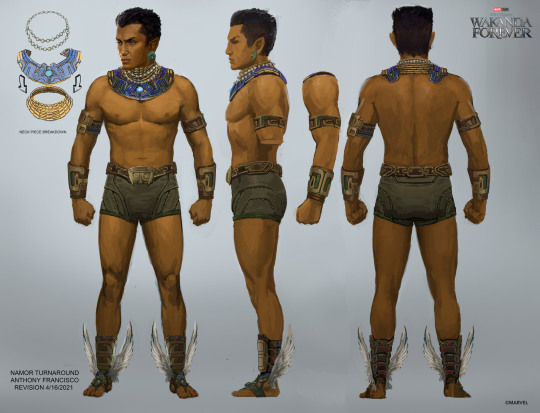
Here is the official turnaround of the final design I did of Namor for Wakanda Forever ! Which will be streaming soon on Disney+ I am so grateful that Ryan Coogler chose my design for the warrior look! I still can’t believe I got to design this iconic character. These designs were then sent to the costume designer Ruth Carter who, together with her team, did an amazing job materialized the costume you see on the big screen! The design process actually begun a year before the production started. It was a fun 2 months of explorations! During this time I worked under THE LEGENDARY Marvel Studios Visual Development Dept. headed by none other than the amazing Ryan Meinerding The team is an integral part in designing the Heroes and Villains of the MCU and Black Panther: Wakanda Forever was no exception. It was fun exploring the look of Namor as well as his people of Tlalocan early on. The necklace for Namor was a treat to design. Looking to Mayan glyphs and architecture for inspiration! But the break though would come in a dream! I would imagine that I was an artist living in that time and looking for work This was when I saw the 2 serpents on the necklace in my dream. Then I woke from my dream and started designing with Kukulkan in mind. I explained that the 2 serpents represented the duality of Kukulkan. He is the bringer of life and death. The pearl in the middle represents the sun/moon or life, so depending how you see it , the winged serpent is either giving you life or taking it away from you. I watched a lot of documentaries about the Mayans, the Olmecs and the Aztecs. I also looked at ancient indigenous people of the north, south Americas as well as in Asia. What are the similarities and differences I can push. I want to share so much more of my journey I learned more of the history of Mexico , the colonization of a people and the attempt of erasing of their language and culture. This was some of the sad parts of my research that made this journey a bit more emotional to me because I also come from a country colonized by Spain. I hope this insight to my design process is interesting to you. Marvel has always been an amazing place to work in, we are encouraged to really push our creativity and some of our keyframes even shape the script! Plus we get credited for our work in the artbooks! I am lucky to have worked along some amazing visual development artists, (concept artist and problem solvers) . Please check out their designs! Adi Granov , Phil Saunders, Phillip Boutté Jr. ,Josh Nizzi ,Wesley Burt ,Keith Christensen , Joshua James Shaw ... if I missed anyone I apologize ! And lastly to all the True Believers out there! to all the fans of the Marvel Comics and the MCU , thank you so much! I wouldn't be able to make a living doing what I love if it weren't for you fandom!
- Anthony Francisco (source)
74 notes
·
View notes
Text
Artist/ Fic Writer Interview
I was tagged by the magnificent darling Chrissy @you-are-so-much-better-than-that who came up with the artist questions, the sensational sweetheart Harvey @mikhailoisbaby & honeypie Willow @ian-galagher thank youuu 🥰
1. Do you post on Ao3? If so, how many works do you have on AO3? If not, where do you post?
I don't post my art on ao3 but on tumblr 😊
2. What is your total art count?
17 🎨
3. What are your top 5 pieces by likes/kudos?
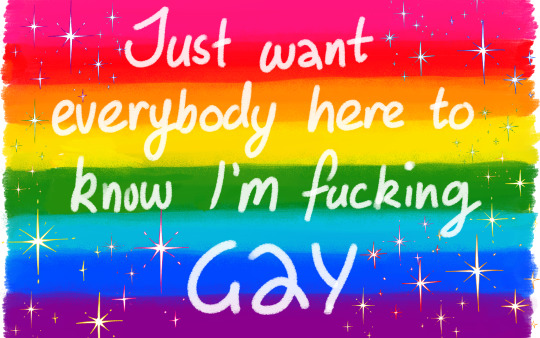
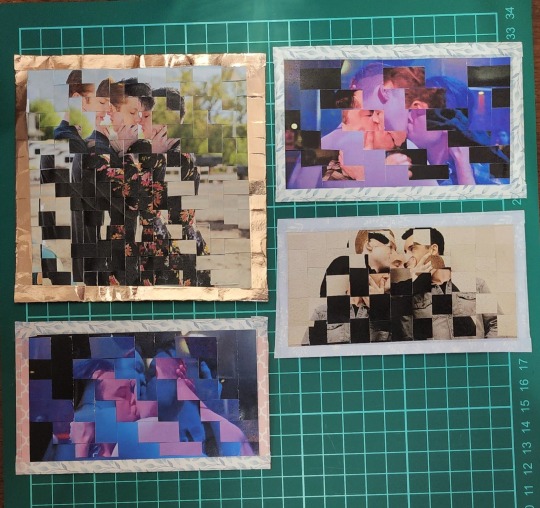
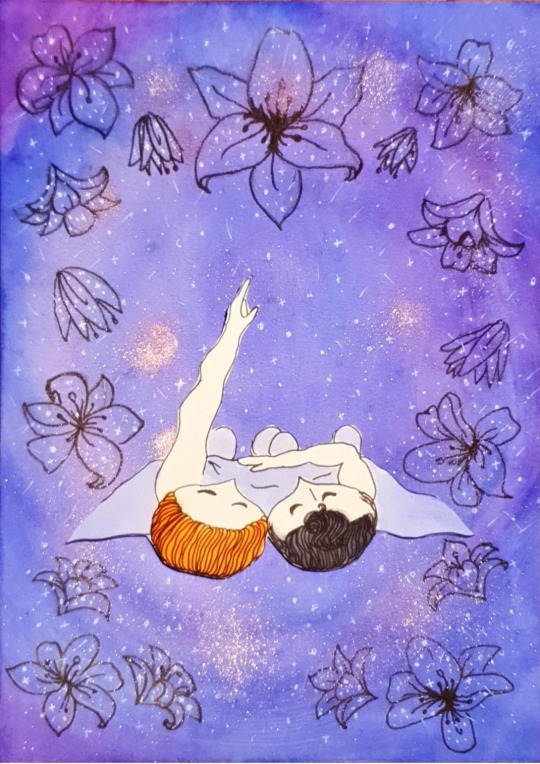
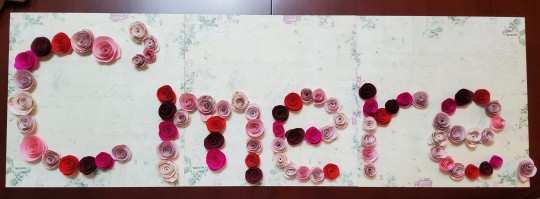
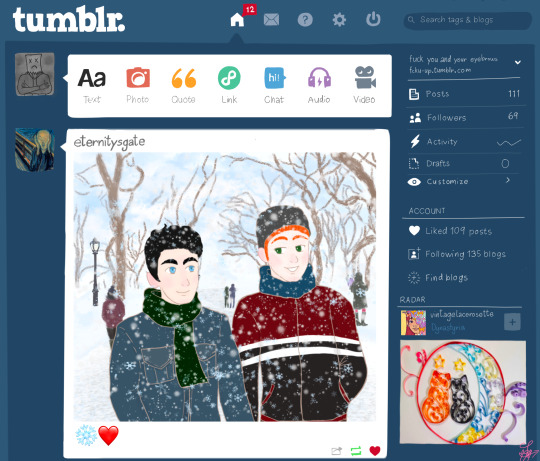
4. Do you respond to comments? Why or why not?
I do respond by liking them bc most comments are in the tags & idk should i respond in the comments? lol
5. What is your current fandom, and what was the first fandom you drew for?
Current fandom: Gallavich & First fandom i drew for & shared my art is Gallavich but probably first fandom was maybe soul eater
6. Have you ever received hate on any art?
Not hate but a complaint on my gallacrafts for theme 11 I'm fucking gay. I got an anon asking why I made the lesbian flag & put the phrase I'm fucking gay & i that should have just done lesbian although I had actually made both but it was on the part 2 bc i had a limit of 10 pictures.
7. What’s a fandom/ship you haven’t drawn for yet but want to?
Maybe Spirk or Soul x Maka from Soul Eater
8. What’s your all-time favorite ship?
Gallavich most definitely, they hit all my likes in a ship plus they're canon & married to boot! #spoiled 😆
9. Do you draw outside of fandom?
Yeah I started getting back into drawing with makinng flowers for mutual's birthday 🥰 I've also made little mascots of baby animals for my niece's baby shower
10. What’s the an art piece you’ve drawn that came out completely differently than you expected?
Probably the GGE2022 for Macy. I had some other ideas. Also their poses were gonna be different like it was either the back of them looking at snow or tumbled into the snow on top of an ny roof top but still not the best at figure drawing so i just did the best of my abilities 😄
11. Do you draw smut?
Not yet but one day 😏
12. Have you ever had any of your art stolen or copied?
Not that I know of
13. Have you ever collaborated on a piece?
No but I think it could be fun to do 🖼
14. What’s an idea you have that you have yet to draw?
Snow king Mickey & Snowflake fae Ian that was gonna be my 2nd choice for the GGE2022 but i loved making fanart for Macy 🥰
Crop top Ian & Mickey in Ian's ROTC hat
Smoo fae Mickey in Ian's arms from a reference pic i saw here
15. What are your drawing strengths?
Faces, hair, blushing & colouring maybe?
16. What are your drawing weaknesses?
Poses, hands & backgrounds
17. What’s your favourite art piece you’ve drawn?

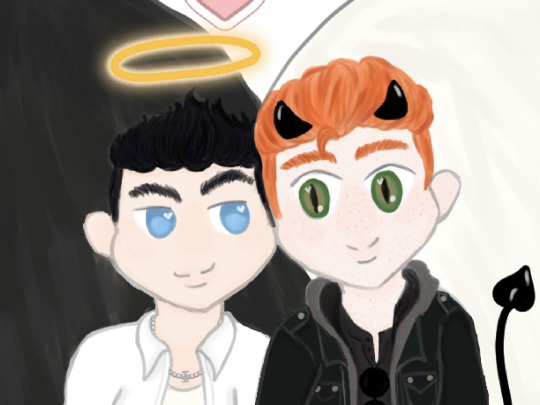
I would say my good omens au I simply adorethe little details I put into the drawing. I referenced Mickey's outfit in Ian's delete scene dream. Ian's outfit is 7x10 just in darker colours. I loved being able to create Ian's ombre eyes by colour picking Cameron's hazel ones. Ian's hair shading. The heart wings & being able to creat the wing texture on the angel wing. AND their signature shows with the timberland & bright read air forces!!! I had such a fun time drawing this 🥰 Also it was my 100,000 post lol
18. What is one thing you’d like to tell people about your art that they might not know?
My gallavich art is the first time I've been colouring my drawings. When I drew a lot in high school I would just do the line art & was too hesitant to colour them.
19. What inspires or motivates you to create for fandom?
Definitely you guys! Being able to make you guys smile. As well as your creations & the creating events 💕🖌
20. And finally, can you describe your process a little? Do you have a favourite place to draw? Do you play something in the background? Do you do research or just go for it? Give us a little insight.
I do like to crawl up into a hunched ball on the lounge couch or my bed (which should stop bad for posture lol) Then I do enjoy playing YouTube video essays about internet history/horror games I'd never play or movie reactions.
Also, I am more of an artist who researches & and works with many references. I got a whole lotta unclosed tabs of Ian & Mickey, body poses & clothes that i forgot to close lol.

So I’m not a fic writer yet! 😉 But here are the interviews questions if you guys wanna ❤️
Fic Writer Interview
1. How many works do you have on AO3?
2. What’s your total AO3 word count?
3. What are your top 5 fics by kudos?
4. Do you respond to comments? Why or why not?
5. What’s the fic you’ve written with the angstiest ending?
6. What’s the fic you’ve written with the happiest ending?
7. Do you write crossovers?
8. Have you ever received hate on a fic?
9. Do you write smut? If so, what kind?
10. Have you ever had a fic stolen?
11. Have you ever had a fic translated?
12. Have you ever co-written a fic before?
13. What’s your all-time favorite ship?
14. What’s a WIP that you want to finish but don’t think you ever will?
15. What are your writing strengths?
16. What are your writing weaknesses?
17. What are your thoughts on writing dialogue in other languages in a fic?
18. What was the first fandom you wrote for?
19. What’s a fandom/ship you haven’t written for yet but want to?
20. What’s your favorite fic you’ve written?
I’m tagging these twinkling hearts if they wanna play 🥰 @mrsinistertype @crossmydna @friend-bear @darthvaders-wife @psychicskulldamage @divine-gallavich @very-sleepy-head @deathclassic @celestialmickey @depressedstressedlemonzest @suchagallabitch @bekkachaos @ianandmickeygallavich @milkoviched @grumpymickmilk @gallavichgeek @annatrow @sisitrip @lalazeewrites @imikhailotakeyouian @look-i-love-u @suzy-queued @y0itsbri @mishervellous @filorux @jomilky @auds-and-evens @xninetiestrendx @beebabycastiel @bravemikhailo @arrowflier @shameless-notashamed @adakechi @skies-below @takeyourpillsbitchh @mikcrymilkovich @tsuga-of-mars @ardent-fox @you-show-me-love @wehangout
37 notes
·
View notes
Text
The Fantastic Music of Slum Village

In this blog, I will be discussing three albums created by the legendary hip-hop group known as Slum Village. These albums are titled Fan-Tas-Tic, Vol. 1, Fantastic, Vol. 2, and Fantastic, Vol. 2.10. I will discuss the differences between each of these three projects and discuss the history behind them. Let's dive right in!
To start things off, allow me to introduce the original members of Slum Village. Taking a look at the picture posted above, original members of the group, from left to right, consisted of T3, Baatin, and J Dilla. The three met in high school back in the 90s and began making music for fun. It's at this point that I would highly encourage people to read Dan Charnas's book titled "Dilla Time" (https://a.co/d/5UVnlxa). It gives amazing insight into the life of J Dilla and his relationship with his family, friends, the music community at the time, and music history as a whole. It's an amazing read.
J Dilla was the heart and soul of the group. He was a musical genius and mastermind who would create the most amazing beats/compositions out of seemingly thin air. His signature drum sound provided an unforgettable rhythm for the entire group to vibe to and share with the world at large. According to Dan Charnas, J Dilla practically invented a new way to feel time by creating, what Dan calls, "Dilla Time". This is a great quick video which shows the idea behind this term that Charnas coined: https://youtube.com/shorts/j2VFEHLkZQI?feature=share . J Dilla wasn't the only person behind the defining sound of Slum Village though. T3 and Baatin provided something to the group that is so meaningful that I hear and feel something new each and every time I listen to any Slum Village song or project. J Dilla was more of a producer for Slum Village, though he would rap on tracks from time to time. T3 and Baatin were the group's main rappers. Kind of like the members of another legendary hip-hop group called A Tribe Called Quest. A Tribe Called Quest originally consisted of four members: Jarobi White, Q Tip, Phife Dawg, and Ali Shaheed Muhammad. After releasing their first project titled "People's Instinctive Travels and the Paths of Rhythm", Jarobi decided to leave the group to pursue a culinary career, which he went on to flawlessly exceed in and eventually came back to the group for their 2016 release of their sixth and final album titled "We Got it From Here... Thank You 4 Your Service". Starting with their second release titled "The Low End Theory" and through their fifth release titled "The Love Movement", the group consisted of the three members who weren't Jarobi. Q Tip and Phife Dawg served as the group's main MCs (Masters of Ceremonies/Master Coordinator's) while Ali Shaheed Muhammad served as the group's DJ and producer. This is how Slum Village was similar to A Tribe Called Quest, though Q Tip was a huge source of production material for ATCQ, but would always credit the group for the production work and never just himself. Back to Slum Village. T3 and Baatin were the main MCs, and to my ears, T3 seemed to always be a more "proper" rapper. I mean this in the sense of he would rap to the flow of the beat and not include any unique characteristics that would distinguish him from other rappers. That's not saying he's not a good rapper! In fact, T3 is an amazing rapper and one can definitely pick his voice and rapping style out of a sea of rappers. Baatin on the other hand was noticeably different. He rapped sometimes in front of or even behind the beat. He would occasionally slurp while rapping, and he would occasionally throw in occult/esoteric bars into his raps. Baatin rhyming about occult/esoteric topics inspired T3 to rap about that stuff as well. Baatin's way of rhyming was akin to Ol' Dirty Bastard's rhyming style from the Wu Tang Clan, a pioneering, historical hip-hop group from the 90s. Ol' Dirty was known as "The Drunken Master" amongst his fans and fellow group members. And this was due to his unique rhyming style which literally sounded as if he was drunk while rapping but had mastered his craft so well that even while drunk, he would include the most witty, elegant, and intricate bars. Baatin may not have been drunk while rapping, but his rhyming style was as free flowing and unique as the way J Dilla's beats and drums felt. The way the group members flowed with each other's energies is a true spectacle to hear. Who else could have done it like that with the equipment they had and the environment they were in at that specific point in time?
Let's get into the group's first unofficial official project titled "Fan-Tas-Tic, Vol. 1".
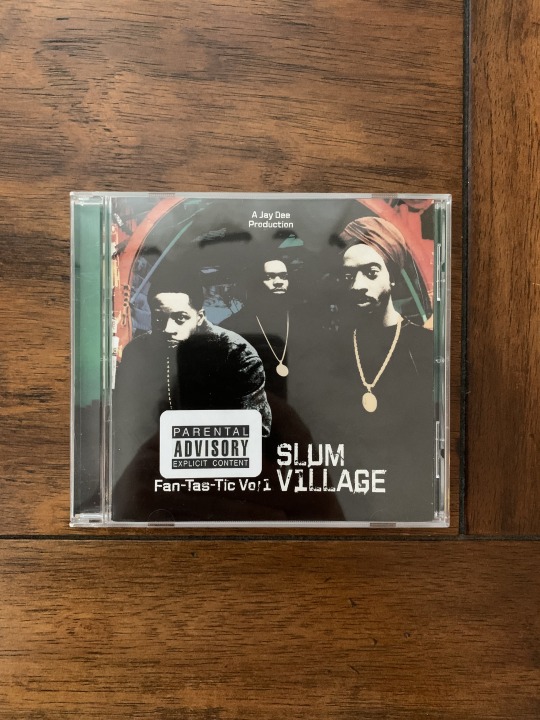

18 notes
·
View notes
Note
What made you first start to ship scotnor???
It wasn't actually a deliberate desicion, but I tend to draw a lot of inspiration from my own experiences with other cultures and nationalities. And I might have mentioned this before, but in 2019 I did a semester in Glasgow, in Scotland, and I met a ton of international students (not so many Scottish though sadly). I also took a class that centred around Scandinavian Scotland, i.e. viking/norwegian influence on Scotland, as well as the class Celtic Civilization II. These classes gave me a lot of insight of the history of Scotland and interactions with locals made for some fun moments and good material.
After having drawn some of these interaction, I started thinking more about how Norway and Scotland's relationship would have been like, and I just found that I really liked their interaction and potensial dynamic. So, this ship is for me based a lot on my own perception of Scottish people, how they behave and their culture, along with that of Norway, and my knowledge of their shared history 😊

39 notes
·
View notes
Text
To the person who sent me the thousand word essay, if you check out my ask policy I don't publish these kinds of long asks. I used to get tons of them and it got to be too much. Also, a lot of your comments contain anti talking points that I will not publish on my blog. But I can respond to some of the issues you raised.
TW/CW - brief mention of homophobia and suicide.
Basically your message was a sort of cataloguing of your doubts about BJYXSZD. To quote your closing paragraph, "Ah....i am just desperate for them to be a couple after all these months and the bts videos and inteviews, but it just doesn't add up anymore. So, as a confused fan, i thought about seeking reassurance to you."
I don't think it's my place, nor is it really anyone's place, to try to convince you or reassure you that GGDD is real. You will either believe or you won't believe. In my experience, people who are filled with doubts and in need of a steady stream of candies and clues to keep them satisfied are going to find themselves on a constant emotional roller-coaster of euphoria and misery.
Let go of your need for certainty.
As I've said in the past, when you let go of your need for certainty you will find that certainty comes a lot more easily. People who need certainty approach GGDD like a detective agency or a hungry ghost, focusing on their craving for proofs and candies that never quite seem to satiate them, and they miss out on the real joy of just being a fan.
A lot of the doubts you listed are things that don't really fit with why BXG believe BJYXSZD. We don't base our belief on the fact that they did a BL show together. We don't base our belief on the fact that they get along well together. We don't base our belief on candies. We base our belief on the insight we accumulate over a period of time, and that's not something that can be passed on to someone else. It's something everyone has to discover for themselves.
GGDD have nothing to prove. BXG have nothing to prove. We are all just here to enjoy them, love them and support them.
My advice: just relax, let go of your need for certainty, and enjoy GG and DD. Certainty will come or it won't, so there's no need to fret over it.
A couple things I felt the need to respond to:
Hidden relationships
Hidden relationships are totally a Thing in the entertainment industry, of course. Andy Lau with his 24 year hidden relationship is a great example. But you seem fixated on the idea that if GG or DD were hiding a relationship, it must be a heterosexual one.
Heteronormativity is a huge part of why so many fans have a hard time believing that GG and DD could ever be a real couple. There can be endless signs that a man is in a gay relationship and the fans will just dismiss it all, but if that man so much as smiles at a woman, fans are immediately ready to believe he's in love with her. Heterosexuality is seen as the default, and that makes homosexuality invisible to a lot of straight people.
You mentioned Leslie Cheung. I recommend this excellent post if you want to see why the world wasn't ready for him. He was an inspiration to LGBTQ people, without any doubt. I think he was equally a cautionary tale for a lot of people, even if the tragedy of his death wasn't necessarily directly related to his queerness or how he was being treated by the public.
There's a trope in society and in media and entertainment, that queer people are tragic figures. Queer characters are often presented as emotionally and psychologically turbulent people who meet untimely, tragic ends. Queer stories tend to be focused around "the struggle of being queer" and the rejection, fear and bigotry queer people face. The violence, the death, the suicides.
How could this not feed into the fears we have as queer people growing up in an often hostile world? How could a story like Leslie's fail to scare as many people as it inspires?
And besides, there are closeted gay couples in the entertainment industry in China.
I have talked about the whole hidden relationship thing, the whole 'needing to appear single' thing, in the past. You can find some of those posts linked at the end of this one. I've also talked about the pressure to appear single (along with the pressure to enter a straight marriage) previously here.
DD and the anti bullshit you've read
I can tell you've read a lot of anti lies in your travels. You're carrying a lot of the toxic ideas that antis spread online. I'm going to take a wild guess and say you spend most of your time on Twitter and YouTube, where these lies are part of the air people breathe on those platforms.
The rumors of DD being in a relationship with that heiress are nothing but harassment and bullshit. She is a known celebrity stalker who has caused scandals with multiple celebrities. Antis spread those lies because they are harmful to DD, not because they're true. DD denies them because they are false, not because he's got something to hide.
DD has never once been spotted with her. He's never once been photographed with her. There exists in the world exactly zero evidence of any common thread between her and DD. Zero evidence that they've ever even been in the same room together. Zero. There's no candy, nothing.
Meanwhile the candy connecting DD and GG together is so abundant it would put Willy Wonka out of business. There are constant reports of them being seen together, evidence of them being together, etc. Some of that stuff is stalker material that I won't share on my blog - such as DD's suitcase being spotted in GG's car a few days ago - but yeah, if you believe in the stalker heiress BS but not GGDD, that only speaks to your ignorance of the situation.
One of the things I find most frustrating about being a BJYXSZD BXG is that we are constantly characterized as spectacularly naive and deluded, meanwhile it's our most vocal critics - the antis, toxic solos and insecure turtles - who unquestioningly believe anything they read.
As for 22*7, you can always tell a DD anti by their willingness to claim DD should have spoken openly about GG during the whole scandal last year. No one who knows anything about GG and DD or about the situation could say in good faith that DD should have spoken up. I view that whole attitude as a litmus test for who knows and understands and truly supports GGDD, and who is either uninformed or an anti.
You can read more about that here and here.
And no, GG has never issued any statement denying BJYXSZD. Neither of them has.
BJYXSZD is not based on old BTS and interviews
I sometimes get sick of seeing clips and photos and metas about the Untamed, I sometimes get tired of talking about the same old interview clips and BTS. I see these things as ancient history - something fun to visit every now and then, but not where I want to live. I don't base my present belief on any of that. All that stuff can ever really do now is give us background on how things started and give us a bit of insight into how they get along and interact.
No BXGSZD that I know of bases their belief on "old BTS and interviews."
Both GG and DD have interesting new projects and endorsements. There's a ton of new content coming out all the time. We still regularly see new evidence that they're together. The past stuff is just for context.
Wrapping this all up, I'll just reiterate what I said before. No one can, or even should, convince you that GGDD is real. That's something you'll have to make peace with for yourself. If you want to get there faster, just relax and enjoy being a fan, and take some time to learn more about GGDD. Certainty may come in time. If it doesn't, well at least you had fun!
Since you are a newer fan I recommend checking out my BXG glossary, along with my masterlist post for some of the things I've talked about in the past.
55 notes
·
View notes
Text
What does it mean to be pagan? (Paganism 101 Ch. 1)
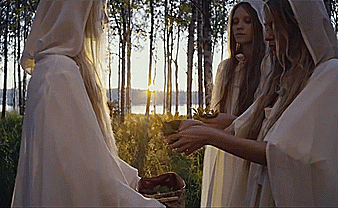
That’s right, y’all! With Baby Witch Bootcamp officially wrapped, it’s time to jump into our next long term series! I put out a poll on Patreon, and my patrons voted for Paganism 101 as our next series. While not all witches are pagan and not all pagans are witches, there is a lot of overlap between the two groups. Both witchcraft and paganism offer practitioners a sense of freedom, a deeper connection to the world around them, and a greater awareness of their personal power.
I identify both as a witch and as a pagan, and I get a lot of questions about paganism. In this series, we’ll go through the basics: what it means to be pagan, the difference between a neopagan and a reconstructionist, and the role of magic in different pagan traditions. We’ll also talk about some of the most popular modern pagan traditions and how to find the right tradition for you.
Let’s start off by answering the question, “What does pagan actually mean?”
Defining “Pagan”
It’s important to remember that “pagan” is an umbrella term that encompasses a wide range of different faiths. Someone who practices Wicca, for example, will have very different beliefs from someone who practices Hellenismos. These different faiths are linked by a shared history, rather than by shared beliefs or practices.
The word “pagan” comes from the Latin “paganus,” which literally means “area outside of a city” or, to phrase it slightly differently, “countryside.” This adjective was used to describe people and things that were rustic or rural and, over time, came to also have the connotation of being uneducated. Originally, the word had no religious association, and was even used to refer to non-combatants by the Roman military.
From this definition, we can gain some insight into what makes a religion or practice pagan. Pagans feel a kinship with the wild or rural places of the world, and are comfortable waking “off the beaten path.”
But how did “paganus” come to refer to a type of religion, anyway?
To understand the religious meaning of “paganus,” it’s necessary to understand a little bit about the religion of Ancient Rome. Rome (the city) was built inside a pomerium, a sacred boundary that formed a spiritual border around the city and its people. Paganus folks were those who lived outside the pomerium and, as such, may not have been strict adherents of the state religion — they certainly wouldn’t have been able to travel into the city for every major festival. They may have gotten a bit more creative with their worship of the gods. However, as previously stated, the word paganus did not have an explicitly religious meaning in ancient times.
The use of paganus as a religious label began after the legalization of Christianity by the Roman Emperor Constantine in 313 C.E. Christianity would not be adopted as the official state religion until 380 C.E., but Constantine’s conversion and decriminalization of Christian worship paved the way for Rome’s transformation into a Christian state. It was around this time, as Christianity was quickly growing in urban areas, that early Roman Christians began using the word “paganus” to refer to those who still practiced polytheism. Rather than referring to those outside the city’s boundary or to untrained civilians, the label now referred to those outside the Church, those who were not “soldiers of Christ.”
As Christianity spread in popularity throughout the Mediterranean, Europe, and Northern Africa, the pagan label was applied to all non-Christians in those areas. The word “pagan” became a derogatory label, implying an inferior and backwards religion.
So, really, the thing that makes a religion pagan is a historical conflict with Christianity. Pagan religions are those that were suppressed or completely destroyed after Christianity became the dominant faith in the region.
This is why Norse Paganism and Kemetic (Egyptian) polytheism, which are very different, are both considered “pagan” while Shinto, a Japanese religion that shares a lot of common features with many pagan faiths, is not. Because Christianity never achieved total dominance in Japan, Shinto was never pushed aside to make room for Jesus.
In the 20th century, people who felt drawn to these old religions started to reclaim the pagan label. Like many other reclaimed slurs, “pagan” became a positive label for a community united by their shared history.

What do all pagans have in common?
This is a tough question to answer because, as stated above, paganism is a historical definition, not one shaped by belief or practice. However, there are some things most pagans have in common. Here are a few of them, although these concepts may take different forms in different traditions.
Paganism…
… is (usually) polytheistic. Most pagans do not subscribe to monotheism, the belief in a single, all-powerful divine being. Some pagans are polytheists, meaning they believe in multiple divine beings with varying levels of power. Hellenic pagans, Norse pagans, and Celtic pagans are typically polytheists. Still others are monists, meaning they believe in a single divine source that manifests itself as multiple gods. Wiccans and other neopagans are typically monists. Many pagans fall somewhere in-between strict polytheism and strict monism. We’ll talk more about polytheism in a future post, but for now just know that the idea of a single, supreme creator is not compatible with most forms of paganism.
… is based in reciprocity. This is a concept that may seem odd to those who grew up around Abrahamic religions: the idea of engaging the gods in a mutually beneficial partnership, rather than one-sided worship. When we connect with the gods, we receive spiritual, emotional, and physical blessings. The gods also benefit, as they are strengthened by our prayers and offerings. (I like to think they also enjoy the company. It has to be lonely, having your body of worshipers supplanted by an anarchist carpenter from Palestine.) The concept of reciprocity is why most pagans make physical offerings to their gods.
Reciprocity also extends to our relationships with other people. Most pagan religions have a code of ethics that includes values like hospitality, kindness, and/or fairness with others. Depending on the pagan, reciprocity may even extend to the dead! Many (but not all) pagans practice ancestor worship, the act of honoring and venerating the beloved dead.
Reciprocity may even extend to the world at large. Some (but not all) pagans are animists, which means they believe that every animal, plant, and stone contains its own spirit. Animist pagans strive to live in harmony with the spirits of the world around them, and may make offerings to these spirits as a sign of friendship.
… embraces the Divine Feminine. Paganism acknowledges and venerates both masculine and feminine expressions of divinity. Polytheist pagans worship both gods and goddesses, while monist pagans see the divine Source as encompassing all genders. In either case, the end result is the same: pagans acknowledge that, sometimes, God is a woman. (Cue the Ariana Grande song.)
Paganism also acknowledges gender expressions outside the masculine/feminine binary. Many pagan deities, like Loki (in Norse paganism), Atum (in Kemetic paganism), and Aphroditus (a masculine aspect of the Greek Aphordite) exist somewhere in the grey area between man and woman.
… is compatible with a mystic mindset. Remember how I said there’s a lot of overlap between witchcraft and paganism? Part of the reason for that is because paganism is highly compatible with magic and other mystical practices. Most pagans believe that humans have, or can attain, some level of divine power. It makes sense that this power would manifest as magic, or as other spiritual abilities. Many of the ancient cultures modern paganism draws inspiration from practiced magic in some form, so it follows that modern pagans would as well.
… draws inspiration from the ancient stories. As we discussed, “pagan” originally referred to the religious groups that were pushed out by Christian hegemony. As a result, every modern pagan is a little bit of a historian. Because paganism was pushed underground, it takes a little digging to find myths, rituals, and prayers that can be used or adapted for modern practice.
Many pagans worship historic deities that you’ve probably read about at some point. Visit any pagan pride event, and you’ll probably find worshipers of Zeus, Venus, Thor, and Isis, just to name a few. Studying and interpreting ancient mythology and archaeological evidence is a big part of modern paganism.
… is a religion with homework. If you’ve read this far, you may be beginning to realize that being pagan is a lot of work. It’s fun, spiritually fulfilling, and very rewarding work, but work all the same. Because very few modern pagans have access to temples, priests and priestesses, or an in-person community that shares their beliefs, they end up having to teach themselves, do their own research, and guide their own practice.
This is incredibly empowering, as it means you are your own religious authority. It does, however, mean that you will occasionally have to open a book or slog through a dense academic article about the most recent archaeological find related to your favorite deity. Thankfully, there’s a growing number of accessible, beginner-friendly books, blogs, podcasts, and YouTube channels to help you in your research.
… embodies a deep respect for the natural world. While not all pagans are animists, most pagans do feel some sort of reverence for the forces of nature. Many pagan deities are associated with natural forces or use the natural world to communicate with their followers. Because of this, not only do pagans respect and love nature, but they’re constantly watching it for signs and messages. (Are you really friends with a pagan if they haven’t called you crying because they found a crow feather on the ground or saw a woodpecker in their backyard?)
Some pagan groups, especially neopagan religions like Wicca, have been classified as Earth-centered religions. Personally, I dislike this term. While it is true that many pagans feel a deep spiritual connection to the Earth and may even venerate local nature spirits, to say that these religions are “Earth-centered” feels like an oversimplification. Wiccans, for example, don’t actually worship nature — they worship the God and Goddess, who they see reflected in the natural world.
… is driven by individual spiritual practice. As mentioned above, very few pagans have access to an in-person community. Because of this, modern paganism largely consists of individual practices. Even pagans who do belong to a community still typically worship on their own sometimes. These personal practices may involve prayer, offerings to the gods, meditation, divination, astral travel, performing religious rituals, or countless other practices. Many pagans have personal altars in their homes, where they worship alone or with their family.
… is a celebration of daily life. One thing I love about paganism is how it makes every aspect of my life feel sacred. Many religions emphasize the spiritual aspects of life while deemphasizing, or even demonizing, the physical or mundane aspects. This can lead to practitioners feeling like they are spiritual beings trapped in a physical body, or like their physical needs and desires are something to escape.
Paganism allows practitioners to fully enjoy being physical and spiritual beings. Pagans reach for the heights of spiritual awareness, while also enjoying earthly delights — recognizing that neither is inherently more worthy than the other and that both are needed for a balanced life.
… is only one of many paths to Truth. Most pagan groups do not claim to be the only valid religious path, and in fact several openly acknowledge the validity of other religions. This is why you rarely see pagans trying to convert other people to paganism — it’s openly acknowledged that paganism isn’t for everyone, and that those who are truly meant to practice the old ways will find them.
~~~
Hopefully, this post has given us a good working definition of “paganism.” From here, we’ll explore some of these individual concepts in more depth and discuss specific religions within the pagan umbrella. Until then, blessed be.
Resources:
Wicca for Beginners by Thea Sabin
Wicca: A Guide for the Solitary Practitioner by Scott Cunningham
A Witches’ Bible by Janet and Stewart Farrar
The Way of Fire and Ice by Ryan Smith
Where the Hawthorn Grows by Morgan Daimler
Temple of the Cosmos by Jeremy Naydler
A Practical Guide to Irish Spirituality by Lora O’Brien
#paganism 101#pagan#paganism#pagan witch#neopagan#wicca#wiccan#feri#reclaiming#goddess worship#celtic paganism#irish paganism#hellenismos#hellenic polytheism#religio romana#heathenry#germanic paganism#norse paganism#kemetic polytheism#kemetic paganism#animism#ancestor worship#eclectic pagan#polytheism#divine feminine#goddess#mythology#theology#history#witch
267 notes
·
View notes
Text
Transcript Lingthusiasm Episode 52: Writing is a technology
This is a transcript for Lingthusiasm Episode 52: Writing is a technology. It’s been lightly edited for readability. Listen to the episode here or wherever you get your podcasts. Links to studies mentioned and further reading can be found on the Episode 52 show notes page.
[Music]
Gretchen: Welcome to Lingthusiasm, a podcast that’s enthusiastic about linguistics! I’m Gretchen McCulloch.
Lauren: I’m Lauren Gawne. Today, we’re getting enthusiastic about writing as a technology. But first, do you wish there was more Lingthusiasm to listen to? Even though this is Episode 52, we have almost a hundred episodes of Lingthusiasm. Some of them exist as bonus episodes over at our Patreon.
Gretchen: If you want to listen to those and have more Lingthusiasm in your earballs, you can go to patron.com/lingthusiasm. This also helps keep the show ad-free. If you like listening to a show without ads, help us keep doing that.
Lauren: The Patreon also fosters this wonderful linguistics enthusiastic community. In fact, we have a Discord server, which is basically just a wonderful chat space for people to talk about linguistics. There are over 350 people on the Lingthusiasm Discord right now.
Gretchen: If you wish you had other lingthusiasts to talk to to share your interesting linguistics anecdotes and memes and general nerdery, and you want more people like that to talk to, you can join the Patreon to also get access to the Discord. We launched the Discord community just a year ago, and it’s been really fun to see it grow and thrive and take on a life of its own since then. If you are already a patron, and you haven’t linked your Patreon and Discord account together, it’s there waiting for you. Feel free to come join us.
Lauren: We have Patreon supporter levels at a range of tiers. Some of them include additional merch. One of my favourite perks is the very scientific Lingthusiasm IPA quiz where we send you a short quiz and then we give you your own custom IPA character which is enshrined on our Wall of Fame.
Gretchen: It’s a fun quiz. We have fun looking at people’s answers.
Lauren: Our most recent bonus episode is a collection of some of our favourite anecdotes from interviews and from other episodes that didn’t quite make it into the original episode. We’re delighted to share those in that bonus episode.
Gretchen: You get to see a bit behind-the-scenes with that episode. Also, do you want more linguistics on your favourite other podcasts?
Lauren: Always.
Gretchen: Constantly. We’re also very happy to do podcast interviews on other shows about various topics. If there’re other podcasts that you like that you wish would do a linguistics episode and interview one of us, you should tell them that! We’re happy to come on. Tag us both or something on social media or tell your favourite podcasts that they could do a linguistics episode because we’d be happy to do that.
[Music]
Lauren: Gretchen, do you remember learning how to read?
Gretchen: Not really. I mean, I remember encountering the alphabet chart in my first year of school, but I already sort of knew the alphabet at that point. I guess there was some point when I didn’t know how to read, and there was some point when I did, but I don’t really have concrete memories of that. Do you remember learning how to read?
Lauren: I feel like I have more memories of learning how to write, just because that’s such a mechanical thing. I remember sitting there writing out a row of As. I definitely wrote the number “five” backward for way longer than I probably should have, which is a really common thing that happens when kids are learning to write because it is a combination of brain skills and fine motor skills. But reading in English is something I feel like I’ve always just been able to do. I mean, I guess in comparison learning to read Nepali, which is written in a different script – it’s written in the Devanagari script – I have more memories of that because I did that in my 20s. Even now, I still feel the real disconnect between being relatively able to chat and really struggling to read and write. I still have to put my finger under the words as I’m going through, whereas with English it just feels like the words are beaming straight into my brain because I learnt to read that language so early in my life.
Gretchen: Yeah, I read at this automatic level. I can’t see a sign that says, “Stop,” on it and not read it in Latin script. But in undergrad I took both Ancient Greek and Arabic. In Greek, I got to the point – because the script is sort of similar enough and I was familiar enough with the letters previously-ish – that I got to the point where I could very slowly sound out words as I was reading them out loud because we had to do a lot of reading aloud in Greek class. But in Arabic, I was very much at that hooked on phonics level where you’re like, /p/-/t/-/k/-/a/. There are a few words that I have as sight words in Arabic. One of them is the word for “and,” which is “waa”, and one of the words for “the,” which is “al”, and one of them is the word for “book” because “kitaab” just shows up all the time. But most of the words I had to painstakingly sound out each letter and then listen to myself as I was saying them. I’d be like, “Oh, it’s that word,” even if I knew it, which is this process that I must’ve gone through in English, but I don’t remember doing it for the Latin script.
Lauren: I think that is one of the things that makes it really hard for people who grow up in highly literate, highly educated societies to tease writing and reading apart from language. But actually, when you step back, you realise that writing is actually super weird.
Gretchen: It’s so weird! It’s this interesting – it really is a technology. It’s a thing you do on top of language to do stuff with language, but it’s not the language itself. There are thousands and possibly millions of languages that have never been written down in the history of humanity. We have no idea. We’ve never met a society of humans, or heard of a society of humans, without language. But those are spoken and signed languages, which are just kind of there. Writing, by contrast, was invented somewhere between 3 and 4 times in the history of humanity.
Lauren: That we know of.
Gretchen: That we know of.
Lauren: There might’ve been a society that did a very ephemeral form of snow writing that we have lost forever. But we have records of 3 or 4 times.
Gretchen: It’s been invented a handful of times. There are a few other cases where there are scripts that haven’t been deciphered by modern humans. Maybe they’re scripts, maybe they’re not – it’s not quite clear. But it’s definitely a handful of number of times. And then once other cultures come in contact with the technology of writing, they’re like, “Oh, this is cool. Let’s adapt this to our linguistic situation,” and it gets borrowed a heck of a lot. But it only got cemented a few times.
Lauren: It’s worth saying that “3 to 4” is a bit squishy because it’s not entirely clear if cuneiform, which is a very pointy form of writing from Babylonia, somehow inspired the Egyptian system that became what we know as the hieroglyphs or if they just happened around the same time by coincidence are something we may never really fully put together. That’s a very contested situation. That’s why we can’t even pin down the number of times we think it was invented.
Gretchen: Cuneiform is the one that’s made with the sharpened reed that you push into your clay tablets or, if you’re some people on the internet, into your gingerbread because there’s some really excellent examples of cuneiform gingerbread tablets people have made, which I just wanna – yeah, it’s really great. The Egyptian hieroglyphs people have seen. But yeah, it’s unclear whether they were in contact with each other and kind of heard of each other in a very loose sense and were inspired by each other because there was some amount of contact between those two areas, or if that was elsewhere. The other two – one is in Mesoamerica, in modern-day Mexico and that area, where they had a writing system there that, again, developed into lots of different scripts as it got borrowed from different areas, of which the best deciphered is the Mayan script from the 3rd Century BCE. There’s also the Olmec script, which is probably the oldest. The Zapotec script is also really old. There’s a bunch of scripts in the modern-day Mexico area that also developed independently.
Lauren: Then the final system arose in China around the Bronze Age a couple of thousand years BCE. Because this script was mostly found in its most earliest forms on oracle bones, it’s known as the “oracle bone” script.
Gretchen: What is an oracle bone?
Lauren: They are turtle bones that are used in divination.
Gretchen: Oh.
Lauren: Yeah.
Gretchen: And, again, the Chinese script, once it developed further, it was also, yeah, influenced a bunch of the other writing systems in the area.
Lauren: I find it super fascinating, with absolutely no historical knowledge or insight to bring to this, that in these three different places that were completely separate and going about their own cultural lives writing arose at a similar time around 3,000 to 4,000 years ago.
Gretchen: Yeah! You wonder what was in the water or something. Well, and it’s partially, I think, that there’s a certain level of writing makes it easier to do things like administrative bureaucracy if you’re trying to keep track of whether people paid their taxes or – it’s a very empire-y thing to have is to develop a writing system.
Lauren: Oh yeah. And it’s absolutely worth stating that it’s not like three people in these three different locations all woke up on the same Tuesday 4,000 years ago and were like, “I’m gonna write a long letter to someone.”
Gretchen: Did they have Tuesdays 4,000 years ago?
Lauren: What you see is this emergence of, “I’m just gonna make a couple of notes so I know how much money you owe me.” Some of the earliest cuneiform tablets we have are just, like, beer supply stock takes.
Gretchen: Like, “Three oxes and this many baskets of grain” or whatever.
Lauren: I feel like it’s very human to be like, “We love writing because it’s poetry, and I can send letters to people I love,” and it’s like, no, it’s actually, “I just wanted to know how much you owe me.”
Gretchen: The king just wants to know if these people have paid their taxes.
Lauren: So, what you get is – although I’m like, “Oh, it all happened within similar millennia,” it is actually centuries of development from just keeping tabs on a few items to a fully fleshed out written system.
Gretchen: What types of things people thought were important to write down – things like legal codes and stuff like that – one of the interesting things that I came across when I was looking this up was that there’s a person named Enheduanna, who is the earliest known poet whose name has been recorded. She was the high priestess of the goddess Inanna and the moon god Nanna in the Sumerian city-state of Ur. There we go. But authorship shows up much later than some anonymous civil servant keeping track of who’s registered which grain or some anonymous priest or something keeping track of who’s made various offerings. This idea of like, “Oh, you’re gonna write poetry,” is a step later.
Lauren: Filing your tax is what is actually one of the best links you have to those ancient civilisations.
Gretchen: There’s this Egyptian named Ptahhotep – that’s “Pta,” P-T, even though I know I’m not pronouncing it that way – he was a vizier in Egypt. He’s also one of the first named writers, the first book in history – or people call him the first book in history – because he wrote these Maxims of Ptahhotep. There may have been people who were writing on more perishable materials that didn’t get recorded and stuff like that. It’s this whole process of, “Okay, I’m going to draw these little diagrams of oxen or something or draw these little diagrams of this plant or this animal or whatever to record what types of things get recorded.” But then in order for it to actually become a writing system, there’s also this step of abstraction that has to happen. This is when you start saying, “Okay, well, the word for this very easily visualisable thing” – so I’m thinking of oxen because the word for “ox” in one of the Semitic languages, I think, was something like /alef/. And so, this “ox’s head” gets transformed into, “Okay, what if this is the sound at the beginning of the word for ‘ox’s head,’” which is /alef/, and it gets transformed into our modern letter A, which is “alpha.” “Alpha” in Greek is just the name of the letter. It’s not “an ox’s head” in Greek anymore because the Greeks borrowed it form the Phoenicians. This level of abstraction that has to go from, “Okay, I’m gonna draw an ox’s head” – if you turn a capital A upside down, it kind of looks like an ox’s head.
Lauren: It’s got its little horns, which are the feet of an A.
Gretchen: Yeah, and there’re all these related languages. You know, Arabic’s got alif at the beginning, even though it doesn’t look like an ox’s head anymore. Hebrew’s got an alef, and Greek’s got an alpha, and all of these alphabets that begin with A. It’s this level of abstraction where you can use this thing to stand for this thing that was associated with an ox.
Lauren: There’re a couple of main different ways that you can relate these abstract images that you’re putting down in writing to the language that you are trying to capture. Of course, being a linguistics podcast, I was gonna bring this straight back to the structure of language.
Gretchen: Well, I think it’s interesting to look at the structure of languages in different areas of the world, and how people reflect those in the writing systems that are developed for those languages. When they borrow a writing system for a language with a very different structure, they end up doing certain adaptations to account for not just like, “Okay, languages have different sounds,” but also those sounds are organised and structured in different ways with relationship to each other. The writing systems often reflect some of that history.
Lauren: The Latin alphabet that both of us are most familiar with has a very approximate correspondence between each character of the writing system and a sound in the language. And I say “approximate” because English spelling is a wonderful historical record of how some of those sound changes have changed over time. I’m just gonna keep this upbeat. You can fall down a giant well of English writing system problems, but to get to a point where the majority of letters have a pretty stable correspondence to sounds that we recognise as phones in the language, and that allows us to write out the words of English.
Gretchen: One of the things that’s true about a lot of the Indo-European languages is that they have a particular ratio between consonants and vowels in the words, where they have a fair bit of consonants in relationship to their vowels but not a ton. You can see this in the writing system because the writing system represents consonants and vowels separately. And yet, when the Greeks were borrowing the alphabet from the Phoenicians – Phoenician is a Semitic language like modern-day Arabic and Hebrew – that alphabet only had consonants in it – letters for consonants – because the vowels were not that important. This is still true of modern-day Semitic languages is they’re often written in writing systems that don’t represent the vowels or kind of optionally represent the short vowels, or sometimes they represent the long vowels, but they’re often written in writing systems where the vowels can be omitted. That’s not really a thing you can do very well in Indo-European languages and still have things understood because the vowels carry enough information that you need to represent them somehow.
Lauren: Even when you have a phonemic script, it’s not necessary to always represent all of the sounds to convey the language.
Gretchen: Right. Then conversely, there are other languages where the vowels are even more important and, in fact, every consonant comes with a vowel or virtually every consonant comes with a vowel. In those, you often get what are called “syllabaries,” where they represent one syllable at a time, because why bother with representing each of these things separately when in every context where you have a consonant there’s gonna be a nearby vowel – or in virtually every context there’s gonna be a nearby vowel – and so you can have a symbol that just represents the whole syllable there. That’s also a structure that doesn’t work very well for Indo-European languages because they don’t have that many vowels. There’s this spot of like they have important enough vowels that you need to represent the vowels somehow but not so important are vowels that you have to represent lots of vowels all the time, whereas languages like Japanese or Hindi – well, Hindi’s Indo-European, but it’s got more vowels, I guess.
Lauren: The Devanagari writing system is inherently focused on the syllable, which is a very different approach to reading. Each character of this writing system, if there’s no vowel specified, it just comes with a bonus vowel. It’s like, “Buy this consonant, get this free letter A sound.”
Gretchen: Right. That’s partly a feature of the writing system, but it can only be a feature of the writing system because it’s already a feature of the language. A similar thing goes for a language like Chinese, where a lot of things are based around a syllable.
Lauren: Then you can go a level of abstraction further where your character in the writing system represents a word-level thing and doesn’t have a direct relationship to the sound correspondence, which is what happens with the Chinese script.
Gretchen: I think it’s important to recognise that there is a phonetic component to Chinese characters. They often make use of – especially for words that are more abstract – it’s not just like, “Oh, here’s a bunch of little pictures that we’ve drawn,” because that’s not capable of conveying abstract concepts like grammatical particles and words for things that don’t come with easy pictures. And so, making use of, “Okay, a lot of our words are one or two syllables long, so here’s a word that’s relatively easy to visualise that sounds very similar to a word that is not as easy to visualise.” We can just add a thing to be like, “It sounds like this, but it’s got a meaning more related to this,” and you can be like, “Oh, it must be this more abstract word.” The classic example, which I’m definitely gonna do the tones wrong on, is that the word for “horse” is /ma/, and the word for mother is also /ma/ with a different tone, and you can add the little horse semantic component with the woman semantic component and be like, “Oh, it’s the word that sounds like ‘horse’ but has to do with something with a woman,” and then you end up with “mother.”
Lauren: This works for languages in China because they tend to be not as long as words in English. We like to add all these extra bits of morphology within our grammar, whereas, again, you get – not a direct rule force – but you get this general tendency where the writing system kind of fits with the vibe of the grammar of the language.
Gretchen: One example of that is in Japanese where they were heavily influenced by the Chinese script, but Japanese actually does have suffixes and other little grammatical words and things you need to change about words. They made some of the Chinese characters that had formerly only had semantic things into just like, “Oh, this makes this sound, and this makes this sound,” because they needed to be able to represent that morphological information that’s not super important in Chinese but is very important in Japanese. You end up adapting a script into something else when it gets borrowed in a different context. Another interesting example here is Farsi or Persian which is an Indo-European language that’s conventionally written with the same script as Arabic except it’s also had a couple of additional letters added because Persian has a P and Arabic doesn’t. They had to create a symbol for the sound P, which is why you get “Farsi” instead of “Parsi” because Arabic doesn’t pronounce that P. So, it makes the P into an F. Sometimes you get people adding additional letters like adding a letter for P. Sometimes you get adapting whole sets of a script.
Lauren: Sometimes you lose letters. English had distinct characters for /θ/ and /ð/ until it was technologically easier to just use the characters in the printing press that English had borrowed. It’s makes me a little bit sad. But also, it makes international people – maybe it’s a little bit easier.
Gretchen: We used to have a thorn for the /ð/ sound, but those early printing presses from continental Europe didn’t have thorns on them. I mean, Icelandic still has thorns. One of the things that I think is more interesting in the closer to modern era – not strictly modern era – is cultures and peoples that are familiar with the idea of writing yet take the idea of writing and say, “We’re gonna make our own homegrown script that actually works really well for our particular language.” One of my favourites is the Cherokee syllabary, which was invented by Sequoyah, who was a Cherokee man who didn’t know how to read in English, but he’d encountered the Latin-based writing system in English. He thought it was cool that the English speakers had this, and so he locked himself in shed for several years and came up with a syllabary for Cherokee. Some of the symbols on the Cherokee syllabary look something like Latin letters, but they stand for completely different things because he wasn’t just learning to read from English. Some of them are completely different. This became hugely popular among the Cherokee in the area. There were newspapers in this in the 1800s. There was very high literacy in Cherokee country. It was really popular. It’s even still found on modern-day computer keyboards and stuff like this. You can get Windows and stuff in Cherokee. It’s this interesting example of that’s one where we can say a particular person was inspired by writing systems but also created his own thing that became very popular.
Lauren: The thing that makes Cherokee so compelling to me is not only did he come up with an incredibly elegant, well thought out, suits the language system, but that he actually got uptake as well – that the community decided to use this as the writing system that they would learn to read and write in, and that it had uptake. It’s very easy to come up with ways of improving the technology of writing but, as I think you’re fond of saying, language is very much an open-source project. You can come up with really elegant solutions, but if no one else is gonna take them up, that’s not gonna be very helpful. So, Sequoyah’s work is doubly amazing for that reason.
Gretchen: People actually made printing presses with the Cherokee symbols and were using those. Another interesting case of this disconnect between a person or people coming up with a system and actual uptake of it is Korean, which has what I think linguists generally agree is just the best writing system.
Lauren: Yeah, we’re like, “Writing as a technology is amazing. All writing systems are equally valid. But Korean is particularly great.”
Gretchen: “But Korean’s really cool.” The thing that’s cool about it from a completely biased linguist perspective is that the writing system of Korean, Hangul, the script, is not just based on individual sounds or phonemes, it’s actually at a more precise level based on the shape of the mouth and how you configure the mouth in order to make those particular sounds. There’s a lot of, okay, here are these closely related sounds – let’s say you make them all with the lips – and you just add an additional stroke to make it this other related sound that you make with the lips. Between P and B and M, which are all made with the lips, those symbols have a similar shape. It’s not an accident. It’s very systematic between that and the same thing with T and D and N. Those have a similar shape because they have this relationship. It’s very technically beautiful from an analysis of language perspective.
Lauren: I love this so much that when we were prototyping a potential script for the Aramteskan language for the Shadowscent books, when I was constructing that language, I also started constructing a script that we never used anywhere, but it was helpful to think about how the characters would write and what writing implements they would use. If you look at the script, you’ll notice that the letter P and B are very similar, but B has an additional stroke. T and D are very similar, but D has an additional stroke. Very much feature driven. And then for the vowels – it’s roughly a quadrant in the writing space – the /i/ vowel is in the top left of the quadrant, the /u/ vowel is in the top right of the quadrant, the /a/ vowel is in the bottom left of the quadrant.
Gretchen: So clever!
Lauren: It was actually just for really selfish reasons that I decided to go with a feature-based system, and that is that it was easier for me to remember if I used the features of the language and made sure that the voiced sound was always identical to the voiceless one but just with an additional stroke. It meant that I only had to remember half the characters.
Gretchen: That’s very elegant. The easy to remember bit is also true about the Hangul script because it’s got so much regularity. The famous quote about Hangul is something like “A wise man can learn it in an afternoon and a foolish man can learn it in a day.”
Lauren: So catchy!
Gretchen: There’s probably a better version of that quote. What’s interesting about it from an adoption perspective is that Hangul was invented by Sejong the Great.
Lauren: Appropriately named.
Gretchen: Who has a national holiday now because of the script. But it was created in 1443. It’s not quite clear whether it was him personally doing everything or whether he had an advisory committee of linguists, but it’s really extremely well-adapted to the linguistic situation of Korean in particular. Even though it’s just also really cool for how it represents the inside of the mouth, but it’s really well adapted for Korean. It was invented in 1443, but it wasn’t popularised in use until several centuries later because for a long time Korean was also using, like Japanese, this adapted version of the Chinese script or adapted version of the Japanese script because of the cultural influences. In the early 20th century, they were doing a much bigger literacy push in Korea to be like, “What want everyone to learn how to read.” And they said, “Okay, we’re gonna have an orthographic reform, and we’re gonna use this script which has this very nice historical pedigree but also is much easier to learn than this complicated thing that we had done that wasn’t really designed for Korean.” It’s got this historical antecedence but also it came back in the modern-day. Now, everything in Korean is written in it. It’s because it’s really easy to learn how to read and write in. The historical uptake wasn’t immediate. It wasn’t during King Sejong’s lifetime where they were like, “Oh, yeah, now we’re all gonna use his script,” people were like, “Okay, king, you’ve got this hobby,” but it wasn’t popularised until later.
Lauren: Even when there is really strong abstraction, humans have this unavoidable tendency to think about the relationship between sounds and other senses. In sound-based writing systems – Suzy Styles, who has been on the podcast before and works on perception across the senses, did an experiment alongside Nora Turoman where they looked at whether people can guess, for writing systems they’re not familiar with, which character was the /u/ sound and which character was the /i/ sound. They found that for a whole variety of scripts there is a much higher than chance – because there’s only two choices. If was completely arbitrary, it would be 50/50. But people do tend, across the evolution of sound-based writing systems, to have /u/ that has a more rounded, bigger sound has properties in the writing system that re-occur. People continue to unavoidably link the sounds of the language to the written properties of the script in a very low-level way. I’ll link to that study. It’s really great.
Gretchen: That’s interesting. It’s not gonna be 100%, but there’s this slightly better than chance relationship.
Lauren: Yeah.
Gretchen: Visual representation of physical information is also something that shows up in ways of writing signed languages.
Lauren: Yeah. Everything we’ve talked about so far, I think, we’ve talked about for spoken languages, but it is possible to write signed languages as well.
Gretchen: There are several different systems in place. Some of them are language-specific like, “Oh, this is the system for writing ASL in particular,” and some of them are kind of like your linguist, International Phonetic Alphabet trying to provide a language-agnostic way of writing signed languages for research purposes but, in a way, that’s sort of impractical, like the IPA for general use. There’s an interesting set of systems. There isn’t as much agreement among representers of signed languages in writing which amounts of information are crucial information that has to be written down and which are optional bits of information that the reader can fill in from their own knowledge of the language and the signer.
Lauren: I think it’s worth flagging that that’s not just a discussion that arises for signed languages. It’s just that those conversations got thrashed out for spoken languages four millennia ago, and we weren’t around when people were arguing about whether intonation had any role in the – or people probably were arguing because it was an emerging thing.
Gretchen: Well, when people were arguing about like, “Do we write vowels or not,” which was a big thing. Do we write vowels? Do we write intonation? And punctuation followed quite a bit after – you know, punctuation wasn’t as much of a thing for several of the early centuries and millennia of writing. They didn’t do punctuation. There’s some level of ongoingness that’s still there. If you think about the internet efforts to try to write tone of voice very precisely and communicate sarcasm and irony and rhetorical questions very precisely, there’s some level of ongoing debate that’s still happening in the spoken language context but not nearly as much as is still happening in the signed language context.
Lauren: Also, just because of the way that signed language communities tend to be embedded within larger spoken language communities, people who sign as a primary language tend to also be educated in the mainstream spoken language, and so literacy gets developed in, say, a language like English.
Gretchen: I think that’s the case for a lot of smaller spoken languages as well where sometimes there’s this imperative of, “Okay, we want to be able to write things to each other” or something, but if there hasn’t been a history of a lot of published literature in that language that you’re trying to read, then it becomes a question of, “Should we teach this in school,” because there isn’t literature there, even though there would be oral literature. It becomes a chicken and egg problem of which comes first, or which do you start teaching first, when you’re constantly comparing stuff against a few very large spoken languages that have this very long writing tradition. It shows up in languages with a newer writing tradition.
Lauren: Education systems have a massive influence there. My grandmother, actually her strongest written language is German. Even though she and her sister speak to each other in Polish, they would write to each other in German because that’s the language they had been educated to write in. Even with people who don’t speak minority languages, the influence of the education system there is so massive.
Gretchen: Reading and writing, they’re separate skills even though they’re often taught together. Sometimes you can read a language that you can’t write or something like that. But it’s a big question. With signed languages, because video technology is now available, if we’d had good audio recording technology 4,000 years ago, the pressure to develop writing systems for spoken languages might not have been as strong – probably wouldn’t have been as strong – even though there are other useful things that writing can do even in the audio-video era. It’s easier to be like, “Well, you can just make a video of the signer,” and then you’d know exactly what they were trying to say and exactly how they wanted to say it. You wouldn’t have this level of abstraction of are you gonna try to write it down in a way that imperfectly represents what a person is gonna do when they’re producing it. It is still interesting looking at some of the signed language writing systems. Some of them, like Stokoe notation and HamNoSys, which stands for “Hamburg Notation System,” they try to very physically represent the characteristics of the signer – where their hands are, where their face is, and things like that. There’s another one that I can’t find the name of that is based on the ASCII alphabet, so you can type it into search engine boxes, which has some advantages as well but represents things more abstractly. It’s got this link with Korean, which was representing this very physical aspect of what the mouth is doing. Several of the signed language writing systems like Stokoe and HamNoSys also have this very physical representation what the body’s doing when it’s being produced. But I think they’re more popular among researchers than they are among actual D/deaf users who tend to use video a lot.
Lauren: I encounter Stokoe and HamNoSys in the gesture and signed linguistics literature. I haven’t really seen them too much outside of that.
Gretchen: I think that it’s easy to conflate a language with its writing system because we’re so used to thinking of English as sort of inextricably linked to the Latin alphabet. But there isn’t a reason, in theory, why you couldn’t write English in the Greek alphabet or in the Arabic alphabet or in a very adapted version of Chinese characters where you’d have to do a lot of adaptation. The same thing is true when you write languages that don’t originally use the Latin alphabet and you have romanisations of them. Writing systems are just as much political and contextual. Some of them have this very tight structural relationship to the properties of the languages they represent and some of them have looser relationships because they’ve been adapted to it later.
Lauren: It’s this slightly looser relationship to language as it’s spoken or signed that means that linguists don’t always include writing systems in, say, an Introduction to Linguistics course. We don’t often talk about writing systems. But when we were putting together the Crash Course series, we ended up making writing the topic of our final episode for the series.
Gretchen: I think partly because people are really interested in it, so why not do something about writing, and also because I think that you can use writing systems as a window into some of the interesting structural features of different languages and how the writing systems represent that. As somebody who’s really interested in internet linguistics and the rise of informal writing and how we represent tone of voice and things like that in modern-day writing, and that’s still a moving target evolutionarily speaking, I think it’s interesting to give that linguistic lens on writing systems even though they are imperfect representations of the languages that they represent.
Lauren: “Writing Systems” is Video 16 of Crash Course linguistics, which is wrapping up this month. If you’ve been holding out to watch all 16 of those episodes, you’ll be able to do so very soon or perhaps even now thanks to the temporal vagueness of podcasts.
Gretchen: Crash Course is the YouTube series that we’ve been working on basically all of 2020. It’s especially popular with high school or undergraduate teaching. If you know people that age, or who teach people that age, that may be a useful thing to send to people. We hope that people find it useful as a resource for self-teaching or for instructing in various capacities.
[Music]
Lauren: For more Lingthusiasm and links to all the things mentioned in this episode, go to lingthusiasm.com. You can listen to us on Apple Podcasts, Google Podcasts, Spotify, SoundCloud, YouTube, or wherever else you get your podcasts. You can follow @Lingthusiasm on Twitter, Facebook, Instagram, and Tumblr. You can get IPA scarves, “Not judging your grammar, just analysing it” mugs, and other Lingthusiasm merch at lingthusiasm.com/merch. I tweet and blog as Superlinguo.
Gretchen: I can be found as @GretchenAMcC on Twitter, my blog is AllThingsLinguistic.com, and book about internet language is called Because Internet. Have you listened to all the Lingthusiasm episodes and you wish there were more? You can access to 48 bonus episodes to listen to right now at patreon.com/lingthusiasm or follow the links from our website. Patrons also get access to our Discord chat room to talk with other linguistics fans – like, do you remember learning how to read – and other rewards as well as helping keep the show ad-free. Recent bonus topics include an AMA with a lexicographer and our favourite stories and anecdotes that we just didn’t have time for in some of the earlier episodes. Can’t afford to pledge? That’s okay, too. We also really appreciate it if you could recommend Lingthusiasm to anyone who needs a little more linguistics in their life. And, hey, tell your other favourite podcasts that they could a linguistics episode, and get us on! It’d be fun.
Lauren: Lingthusiasm is created and produced by Gretchen McCulloch and Lauren Gawne. Our Senior Producer is Claire Gawne, our Editorial Producer is Sarah Dopierala, and our music is “Ancient City” by The Triangles.
Gretchen: Stay lingthusiastic!
[Music]

This work is licensed under a Creative Commons Attribution-NonCommercial-ShareAlike 4.0 International License.
#linguistics#lingthusiasm#language#episode 52#transcripts#writing#writing techonology#cuneiform#chinese oracle bones#scripts#orthography#technology#cherokee syllabary#hangul#olmec script#mayan script#stokoe notation#hamnosys
81 notes
·
View notes
Text
DownRight Fierce Dev Update (9/2021)
Not sure if this is something folks here would want to see, but I'll share this update I shared with patrons for the original visual novel I've been working on, DownRight Fierce. It was conceived back in, like, 2014, but since just before the pandemic hit, I've been working on it as a visual novel. It's sort of like...if Street Fighter and Butterfly Soup had a kid? That was born before Butterfly Soup came out? And has been slacking off for a few years? There is a fully playable, mostly presentable demo of the prologue and first three chapters, feel free to contact me if you're interested in trying it out and providing feedback.
Thanks to the support I've received on Patreon lately, I've been able to commission more outfits for the main characters, new expressions, and was able to pay Hayley to re-organize the sprites so I have some more control over mixing and matching different things. We've also implemented a new pose for Nishiko's sprite when they're sending text messages (on their antiquated cell phone).

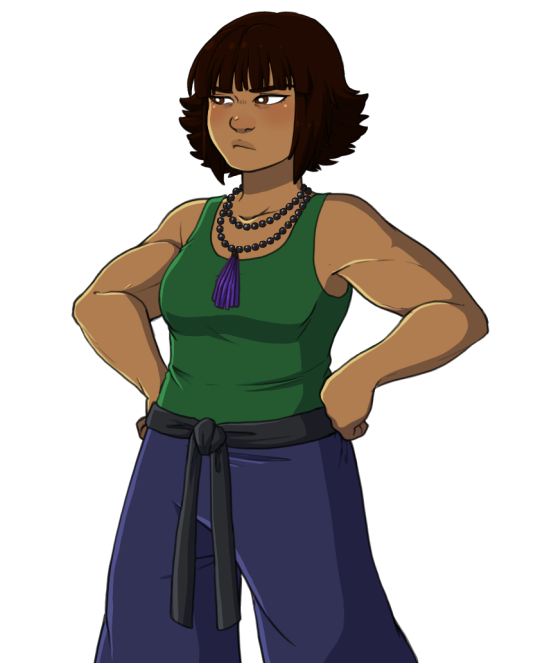
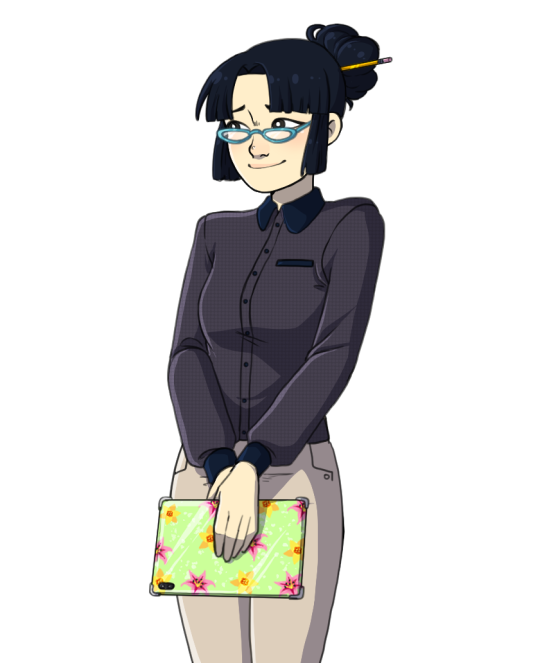
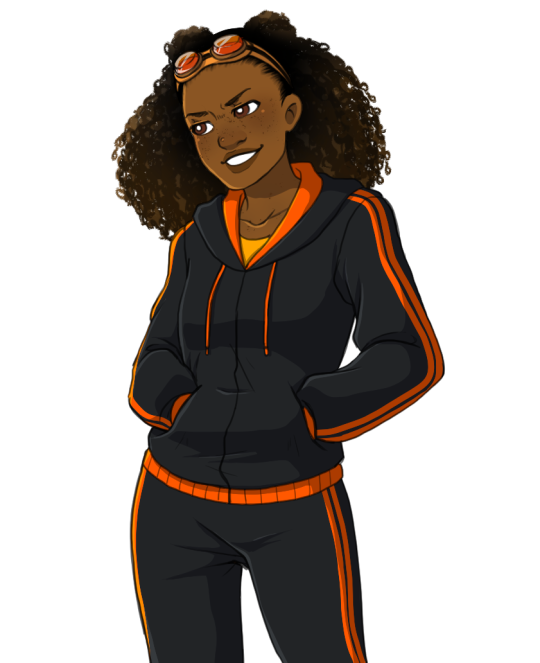
(all of the character art so far I have commissioned from my friend Hayley Sakura-Rose12)
I ended up deciding to have that sprite made when I implemented a whole text convo with Seiko near the end of Chapter 3. (or partway through the chapter, depending on what the reader chooses - OR they can even skip this conversation altogether, potentially)
The biggest updates to DRF lately have mostly been cosmetic: adding in more facial expressions and effects.
One example of this has been incorpating a more seamless and atmospheric effect for moments when Nishiko gets lost in thought.
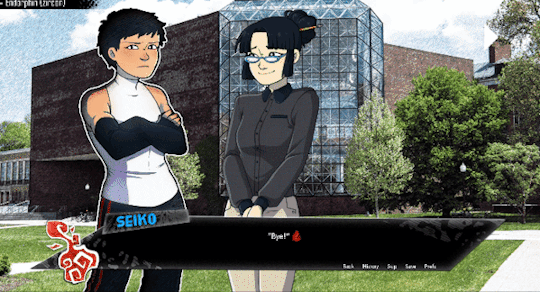
There will be a recurring and increasingly important component tied to this, so I'm glad Jenny helped inspire me to pursue this kind of idea. You can also see here a version of Nishiko's sprite which has been visually updated with more texture, alternate color, etc., and that's something she intends to do with the other characters when time allows (she's been very busy for like, over a year now).
Fire and smoke are key visual symbols for Nishiko's character, so Jenny has been helping me figure out ways to express this more through the UI, etc.
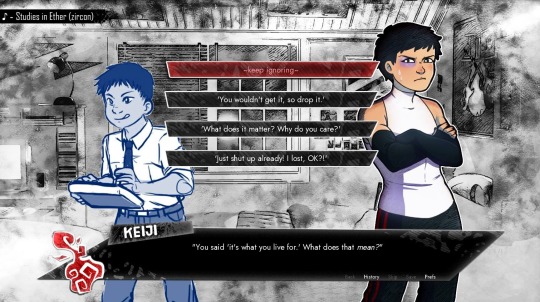
(my wife Jenny has worked on the UI, giving it a more gritty look, and she's modified Nishiko's sprite in this image to give extra atmosphere to the character sprites; she also took a placeholder image and did work on it to showcase a potential art style for the backgrounds; we're considering something like this, though maybe including more color, perhaps intentionally depending on the setting)
But it's not just been visual stuff. I've also been adding in extra content, and incorporating more choices and elements that affect and are affected by the stats running in the background.
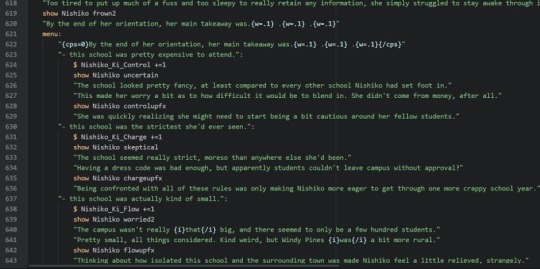
I've added in new short classroom scenes to help better illustrate Nishiko's experience inbetween social activities, while simultaneously using them to imply elements regarding Nishiko's attention span, as well as flesh out the lore of the world.

I've been a bit inspired by Tuca and Bertie in some weird ways, as well, trying to build lore within my own fighting game inspired world with references that double as, well, world building (like alluding to Street Fighter antagonist M. Bison via a political dictator who existed in this universe's history), including entire chunks of conversation that go in different branches based on weird Capcom humor that also serves to establish backstory.
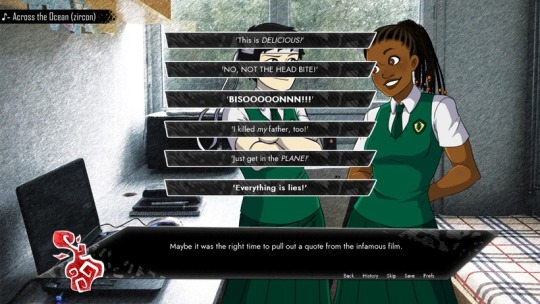
Nishiko and Kayla bond over love of a dumb cheesy horror flick that's essentially one big meme featuring the 90's Street Fighter cartoon. The drinks in the vending machines are all Capcom references, but serve as a means of letting the reader more manually increase a stat of their choosing - and since they're vending machines, they recur, so as the reader might get to know what each drink is, they might make a deliberate choice to increase a specific stat on purpose, in a similar way to choosing to exercise, or meditate, or study.
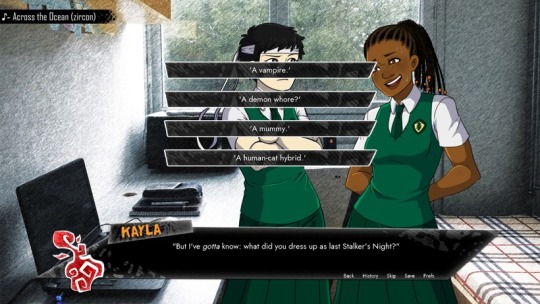
A convo about Nishiko's prior schoolyear incorporates Dark Stalkers references while also, again, letting the reader affect stats in a narratively retroactive way.
I've fleshed out conversations in Chapter 3 to have lots of dialogue most readers won't see in a single playthrough, as well as making more efforts to lean readers toward experiencing certain scenes or moments they might have missed earlier, while allowing the possibility of skipping or missing out on scenes entirely should they choose.
For example, the end of Chapter 3 is focused on Nishiko's relationship with Seiko. There is a text chat convo that can happen in one of two different parts of the chapter, and an in-person convo I'm currently working on (the last planned new content for the demo). Both can be experienced, or one or the other, or the can both be skipped. I don't want to make the entire social life something optional, but I do want to have there be parts like this where the reader can choose to skip interacting with a character if they truly don't want to, to help reinforce the idea that every interaction is, in a sense, a deliberate choice.
Even something like picking 'the BAD' choices is something I want to not just feel like, say, Undertale's infamous 'genocide run' but rather something that is an expression of anger at the world around the main character, which even has some specific benefits - because people don't just become jerks because they like to feel bad, but because it serves them in some beneficial way. As a slight example, if the reader pushes Nishiko to become aggressive, their 'Psycho' stat will increase, which can lead to them having even more aggressive choices later, which further increase that stat. But as that stat increase, Nishiko will become more physically perceptive to certain details about the world around them, but in material ways rather than social ways. For example, they might sense certain inklings of things that allude to later plot points earlier than someone who is more cooperative and might learn more social backstory elements. It's likely not going to be some huge, monumental difference, but it hopefully will make a second playthrough feel noticeably different and give the reader more insight into certain things.
The planned demo will feature the prologue and the first three chapters. By the end, all four main characters will be introduced, and the reader should get a pretty good idea through bits of writing and visual presentation that the choices they make won't change the primary narrative, but will affect certain details and aspects of how things play out. This is actually related to a big plot element itself that will become important later. But for now, it's been really fun adapting content I wrote over five years ago into this format, fleshing it out, and trying to work out ways to not only make that content function better in an interactive format, but also just how to lay more foundation and foreshadowing for what's to come.
While the visuals are still far from finalized even for this demo, I do have a private build uploaded for anyone genuinely interested, as I still haven't received much in the way of feedback so far. I'm planning on releasing a public demo to itchio later on when we can get the visuals to look more finalized.
12 notes
·
View notes
Text
As some of you may know, I participate in a military history book club with some other volunteers at my museum. It's a lot of fun for me because it forces me to read about a wide variety of conflicts and perspectives and discuss them with a group of pretty smart people.
At least once a year we try to read a book that's been adapted into a movie. So far we've done The Great Escape, which was pretty accurate to the book, and Monuments Men, which wasn't. This month our selection was Enemy at the Gates, by William Craig, and the 2001 movie of the same name.
I wasn't expecting anything amazing from the movie version of Enemy at the Gates - Hollywood has a specific set of goals for storytelling and historians have another, and it's just the way of the world that they don't often meet in the middle.
I feel like I should start by saying that I didn't like William Craig's book. Written in the 1970s, the big draw factor for Craig was that he was interviewing and quoting men and women who were actually at the battle, much in the same way Lyn Macdonald chronicled the First World War. While this gave a lot of insight about the lived experience of the battle, I didn't feel like I understood the context of Stalingrad and how the armies actually moved and fought. The other thing I didn't like about the book was the way it ended - Craig used many, many more German interviews than he did Russian towards the end of the book, and as it wrapped up I found myself feeling sorry for the Germans, which isn't necessarily the way one wants to end a book about a battle the Russians won.
Which brings me back to the movie. This was my second time seeing Enemy at the Gates - I watched it a long time ago when I didn't know much about World War Two in general, and the one thing I remembered about it was the love story, which, obviously, doesn't really show up in the book.
But the one thing I *did* notice this time around was the way Rachel Weisz's character Tania is written, and I feel like she can offer us a lot of food for thought on the way we write OFCs, because Tania - and I hate to say this - is a bit of a Mary Sue.
The character is based, loosely, on Tania Chernova, a young medical student who fought as a partisan and trained as a sniper under Zaitsev, later becoming his lover. According to Craig, she "embarked on a relentless war against the enemy, whom she always referred to as 'sticks' that one broke because she refused to think of them as human beings." She seems like she was a pretty tough lady. (There are other historians who think Craig may have made her story up, so we should probably take this with a grain of salt.)
The movie's Tania, however, is first presented as a pretty face on a train car as Zaitsev and his fellow soldiers are carted off to the city. Later they meet again in an underground apartment. She's a student of German literature - a language skill that the political officer Danilov can use. Her role in the story, immediately, is to cause friction between Danilov and Zaitsev. Later in the movie she reveals she knows how to fire a rifle because her family are Jews who would need to defend themselves, and they were planning to emigrate to Palestine. The backstory sounds like we're checking a box, like we can't have a World War Two movie if we don't have a Holocaust narrative in there somewhere. Don't get me wrong - stories like the Bielski partisans and the Ritchie boys are important and should be told, but the inclusion of this detail doesn't serve this story at all except to garner pity from the audience - which can be accomplished in so many other ways.
There's just too much about Tania that's convenient - that she already knows how to use a rifle, that she speaks German but her political bona fides are never questioned, that she's a Jew who watched her family die, that she's pretty and remains pretty for the rest of the movie. These things come up exactly when it serves the story - not before. We need a compelling emotional moment and Danilov magically figures out Tania's a Jew, at which point she shares the story about watching her family get shot. It's a little too neat. And there's nothing in the movie to reflect some of the things that made the historical Tania interesting and compelling - the line about sticks, her grit and courage, her unwillingness to show mercy to the men occupying her city and her country.
And, of course, she dies beautifully and tragically to inspire Zaitsev and Danilov to help win the battle. None of the action she takes in the story is for her goals or dreams - it's always for the two leads.
So, where does this leave us with OFCs?
Good characters need motivation - they have reasons for being where they are and doing what they do. Sharing that with your audience helps us understand them, take their side.
On a related note, characters need backstories. They don't need to be groundbreaking or filled with trauma, but they do need to be consistent, and they need to be brought up from time to time. These folks started somewhere before the story began, and they'll need to end somewhere when the story stops. Write nobodies. Write medical students who have to learn to be snipers. Write characters with skills they will never have to use.
And, lastly, Let people get messy - with their emotions, with their uniforms, with their lives. The movie makes a real hash of this love triangle, but real Chernova apparently crawled through a sewer and bluffed her way out of a German field kitchen. No artful Hollywood dirt smudges here.
13 notes
·
View notes